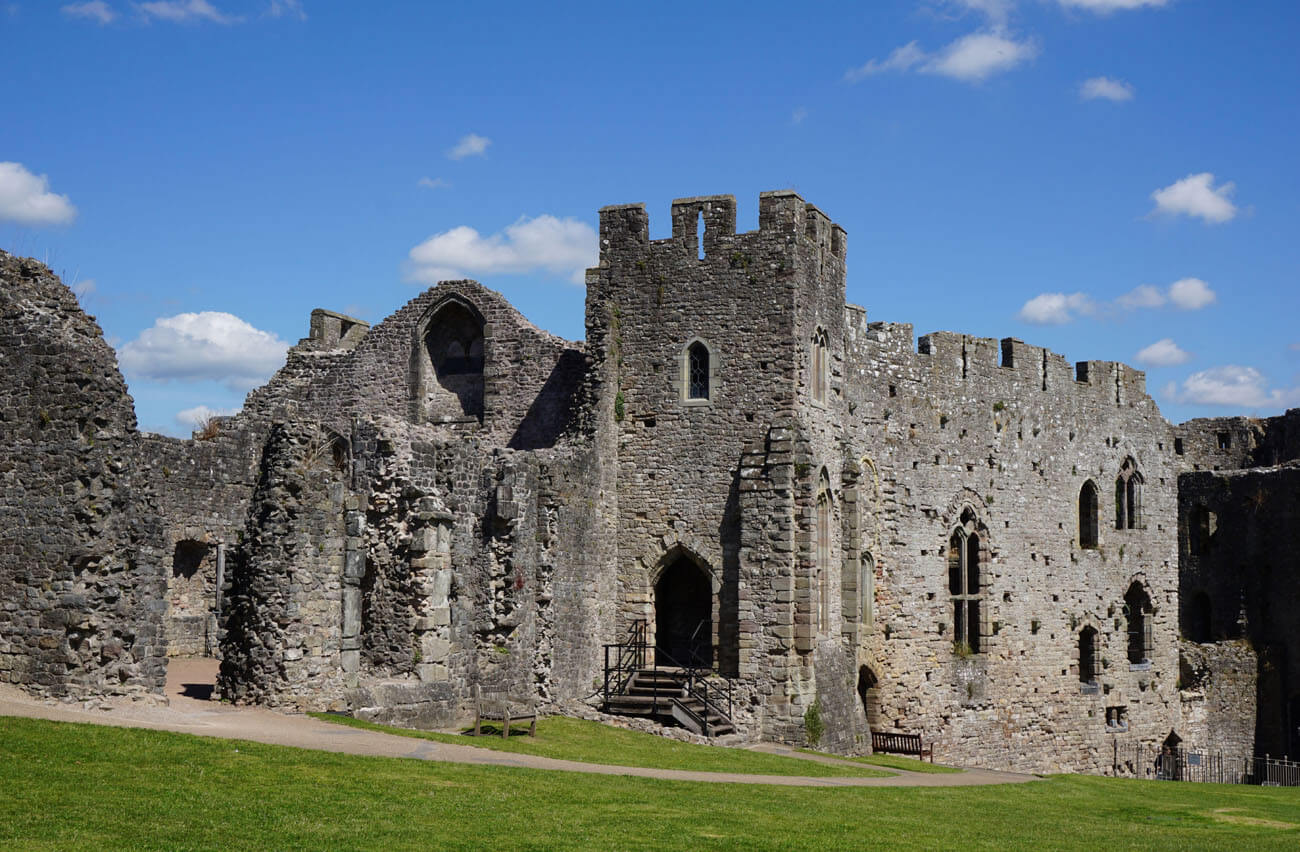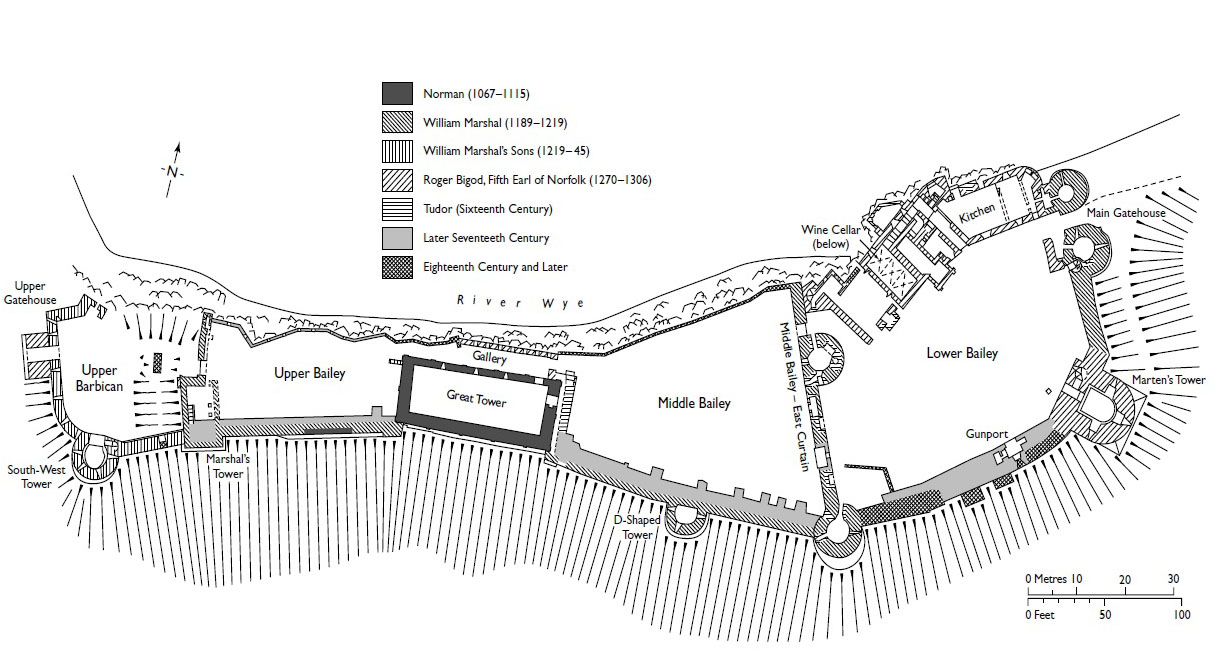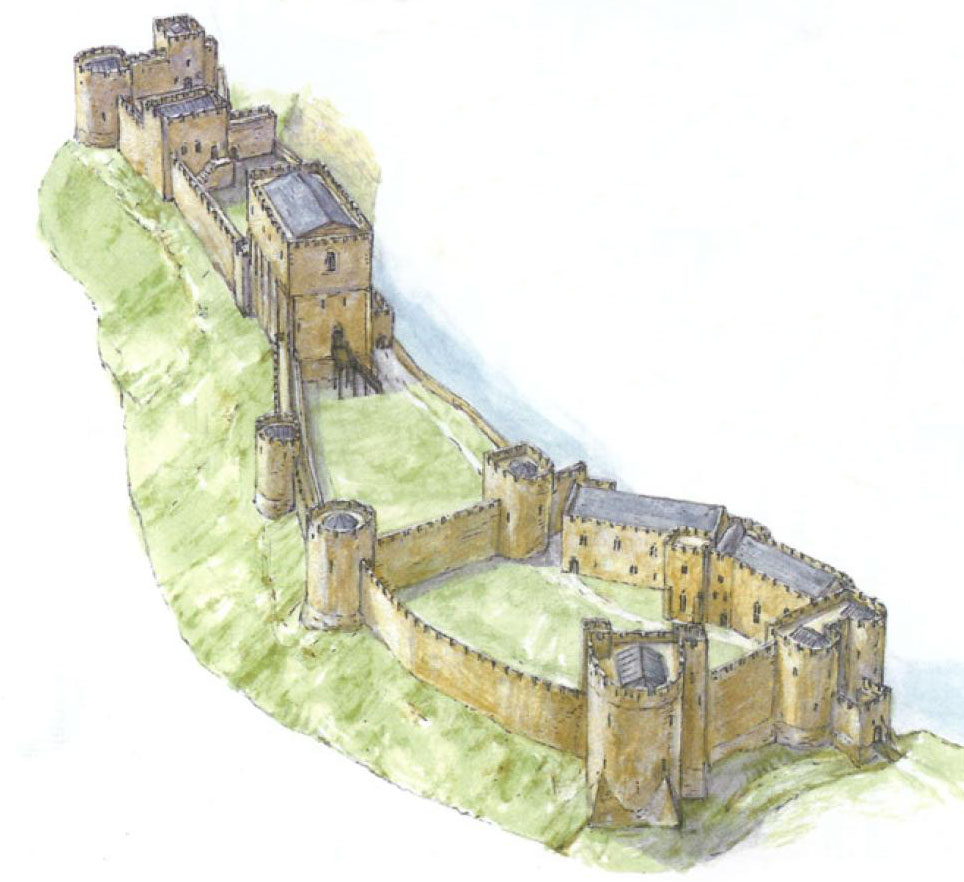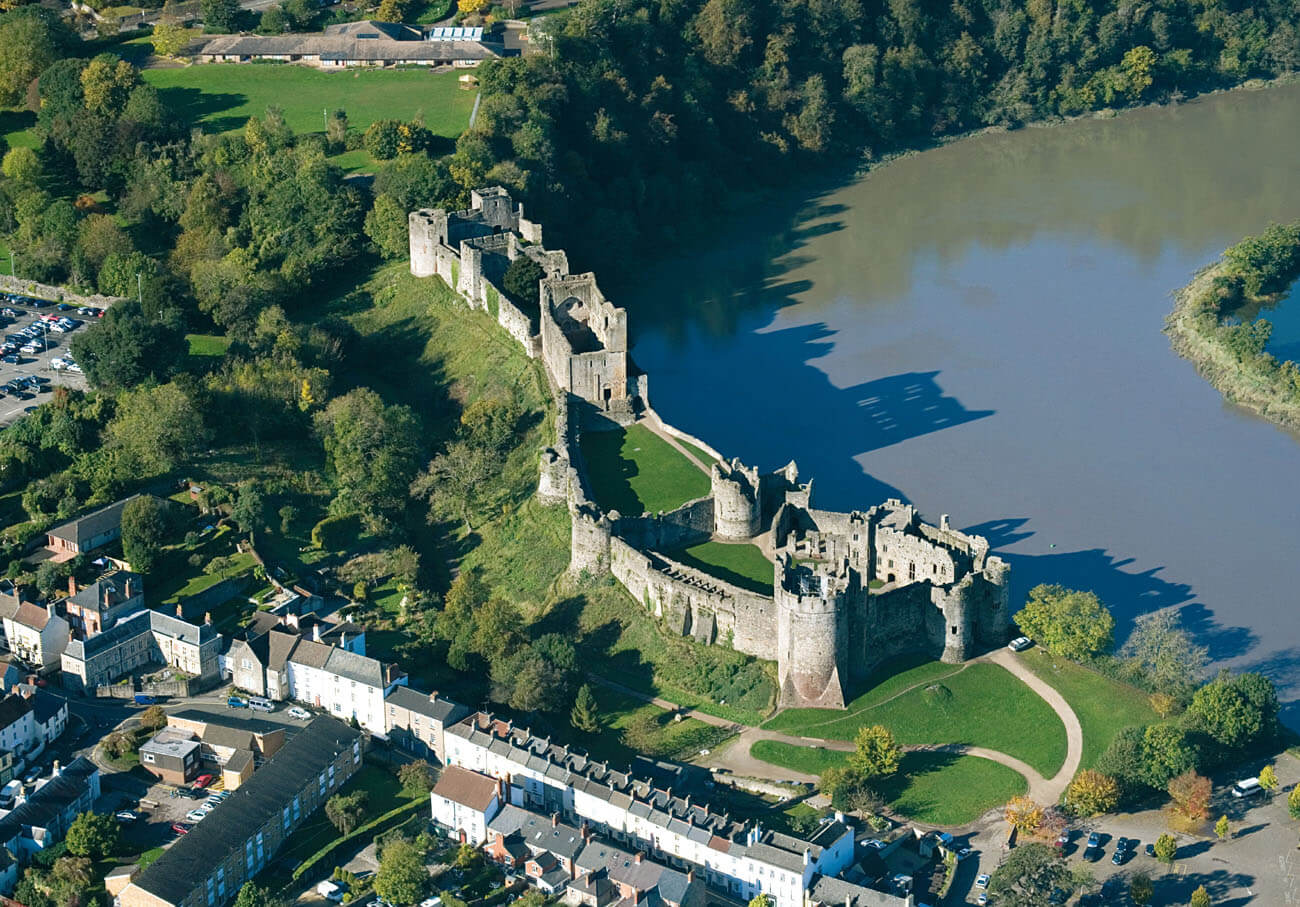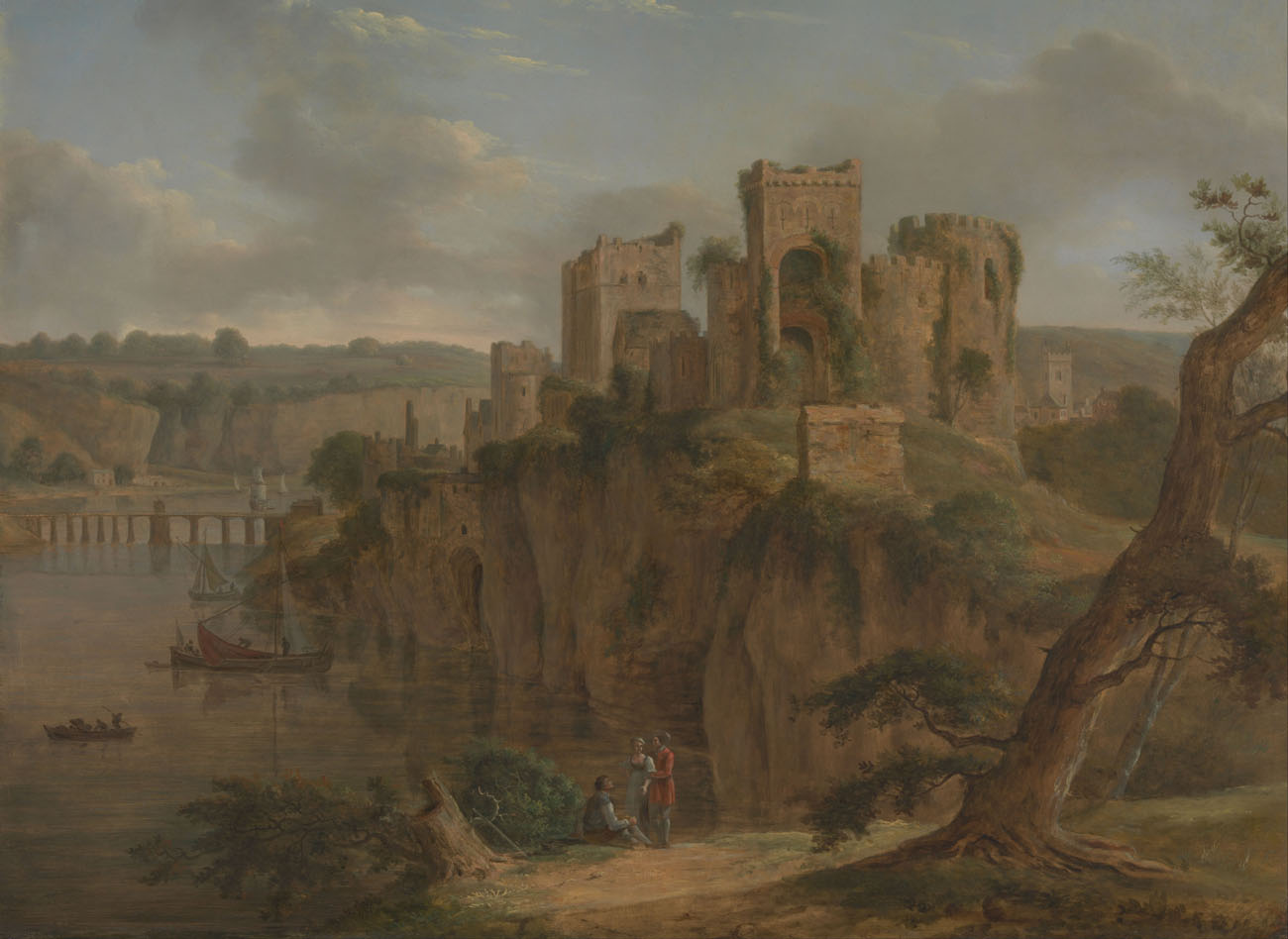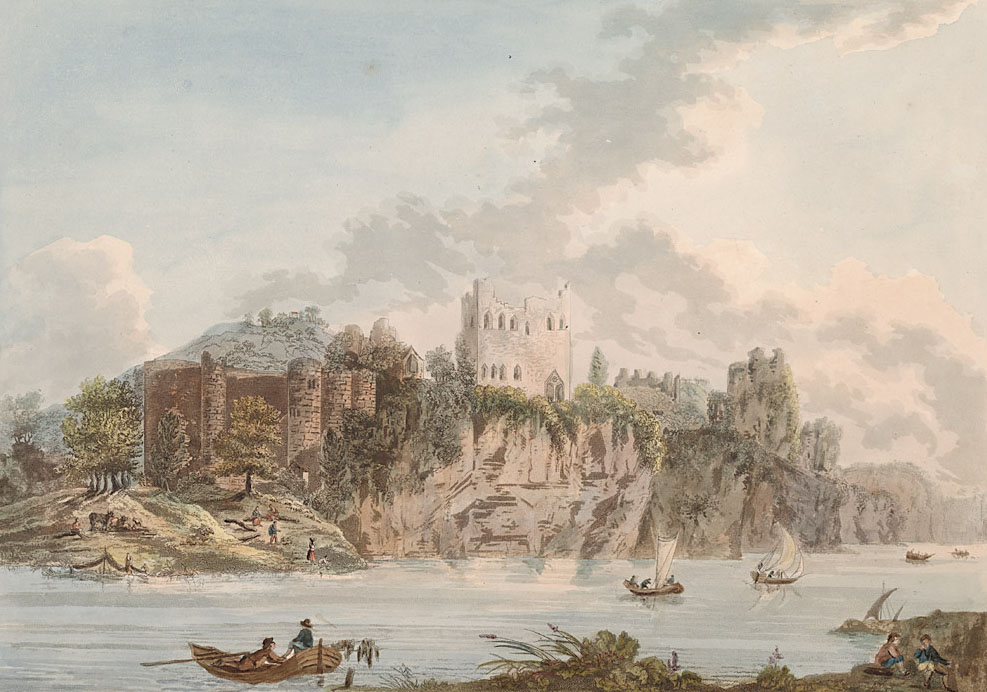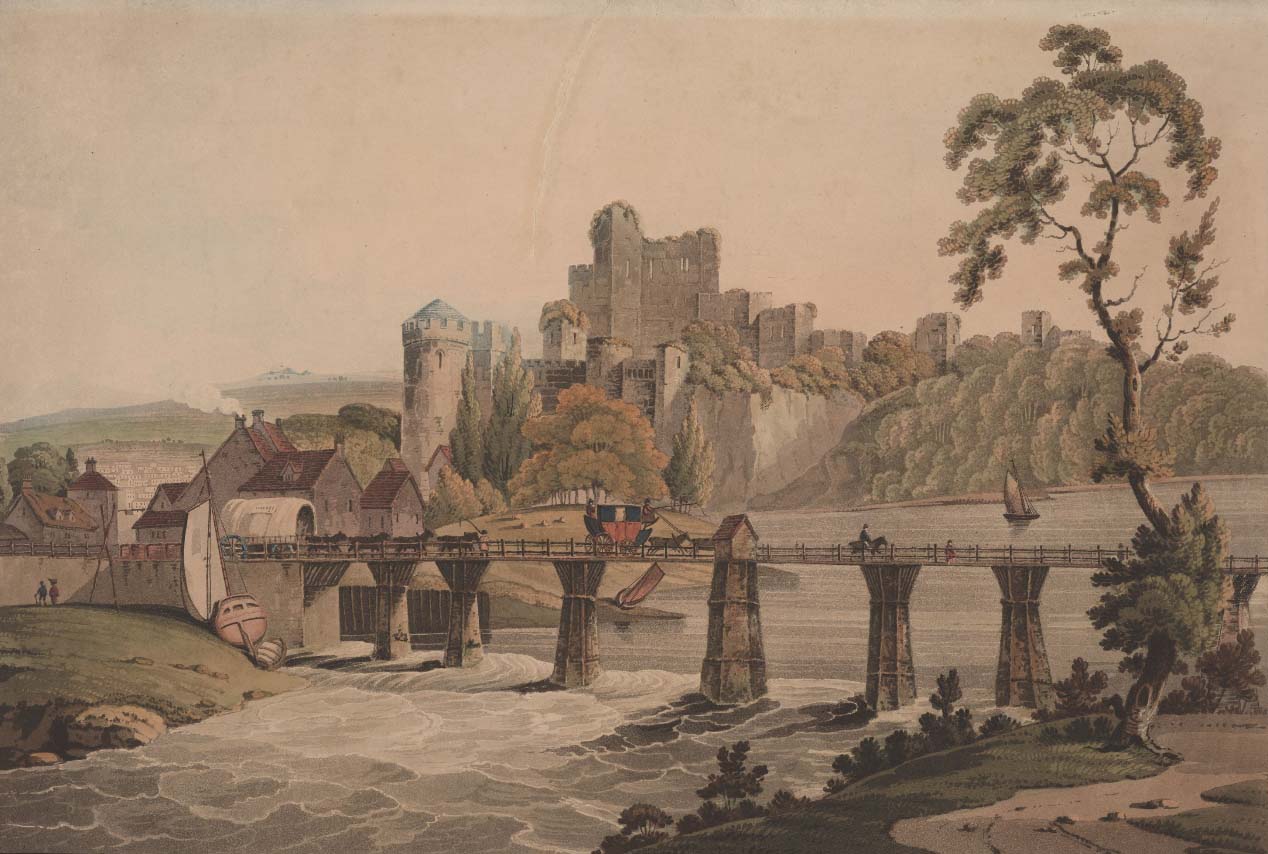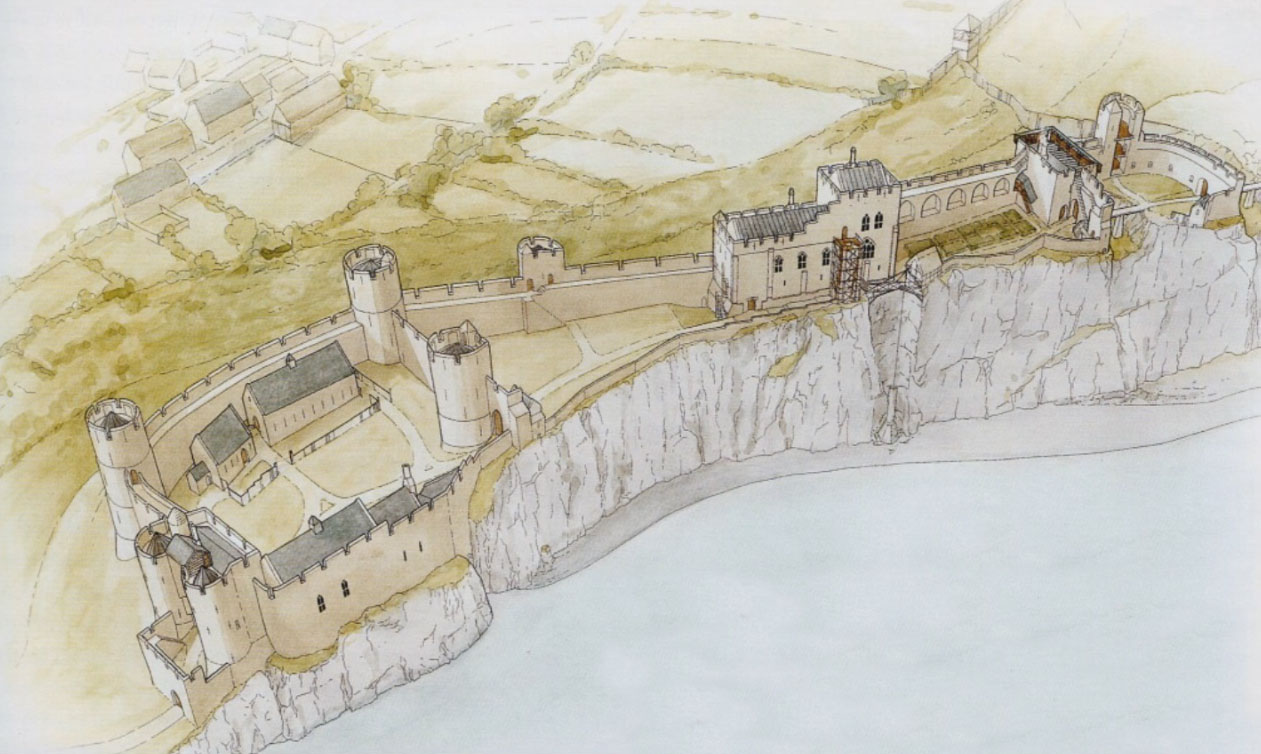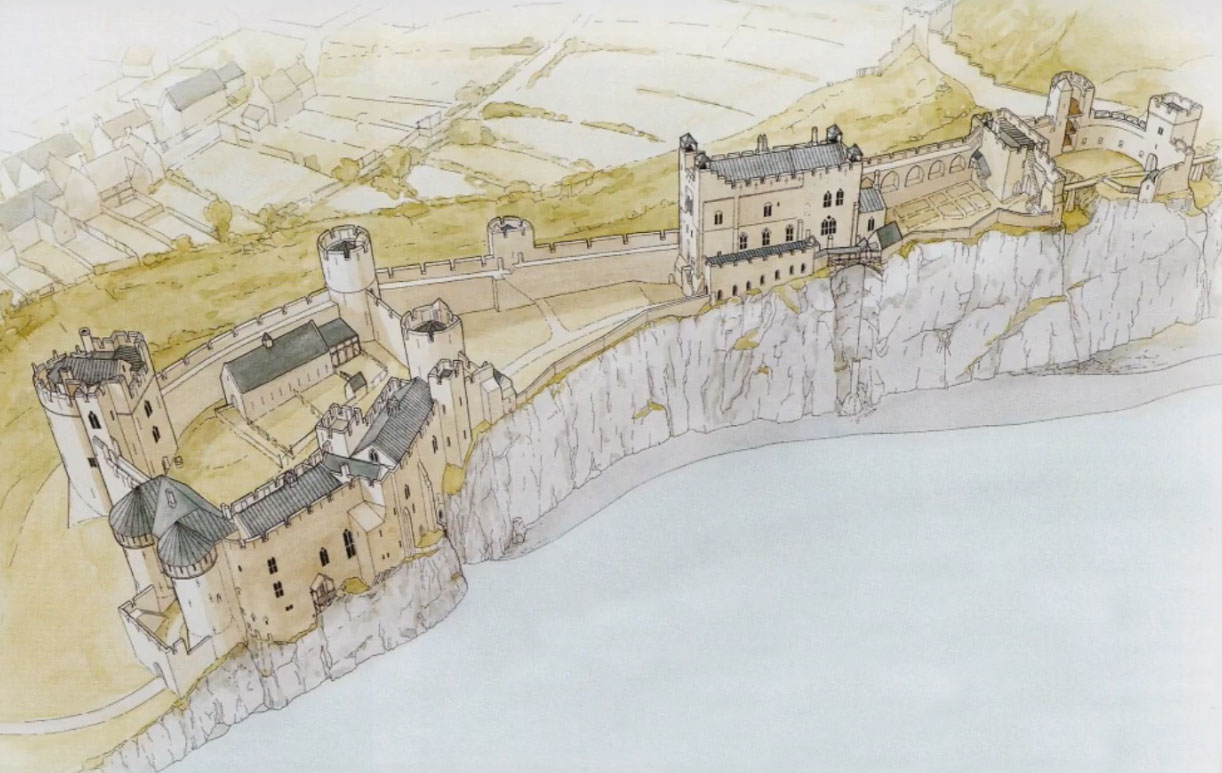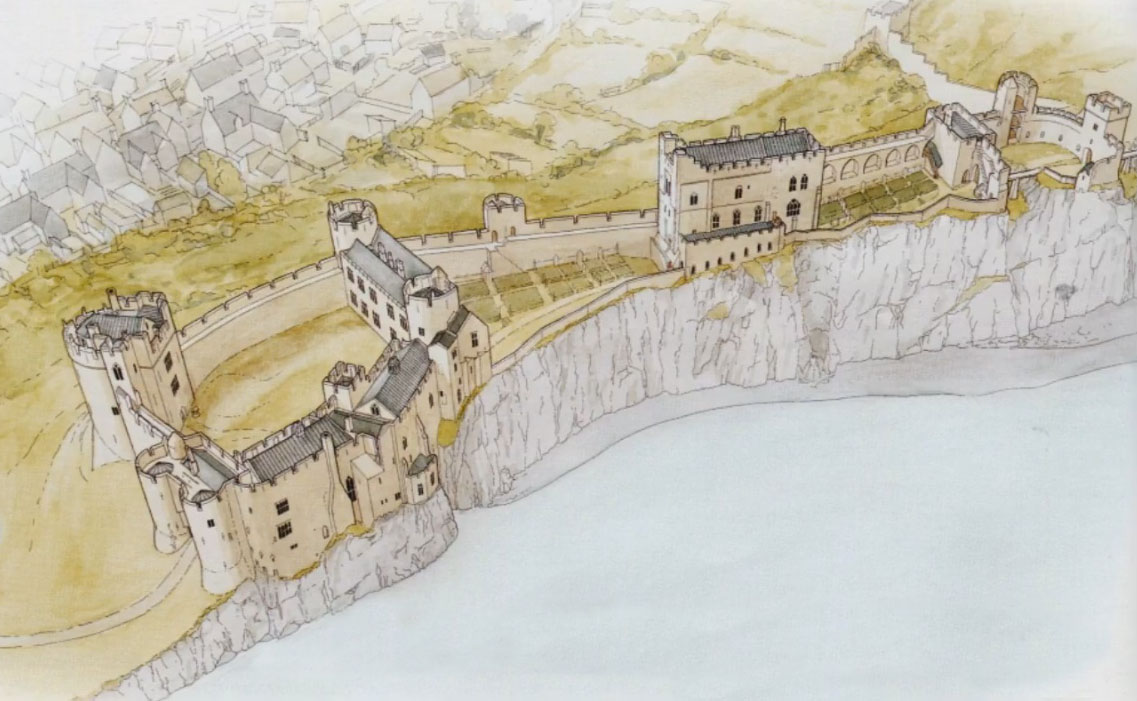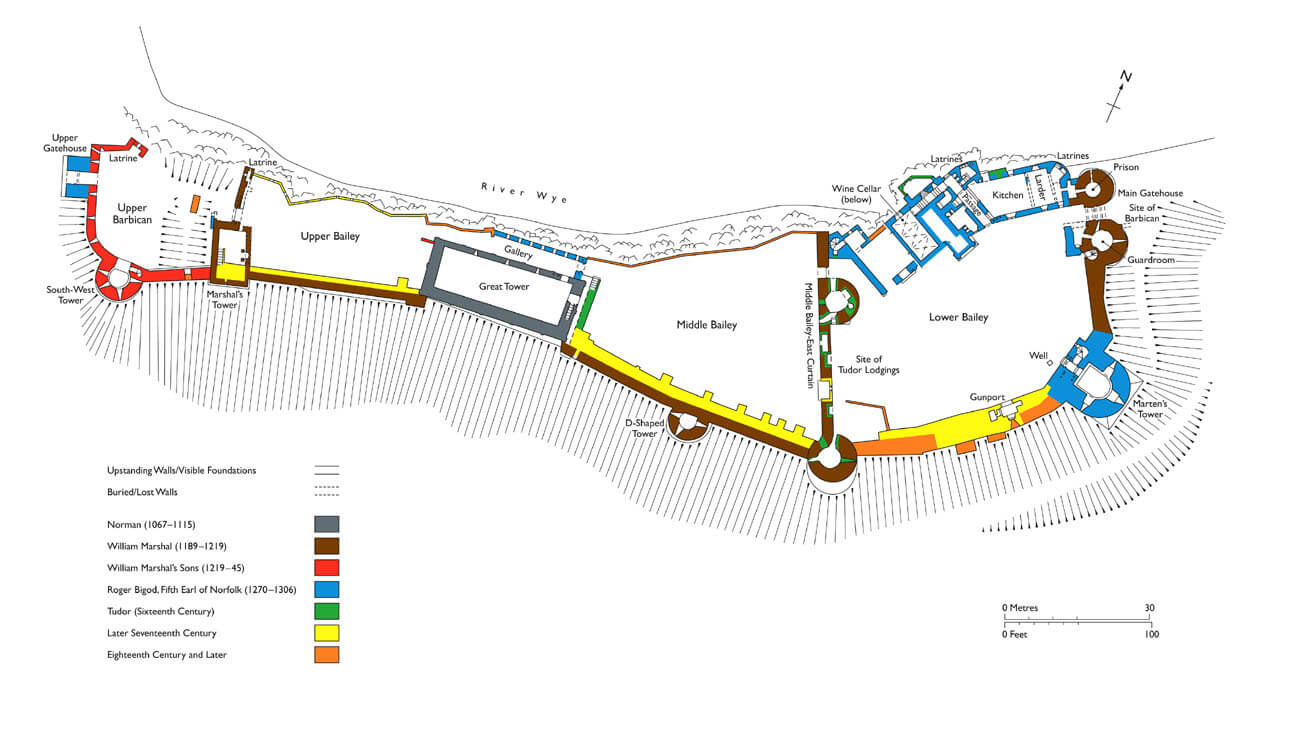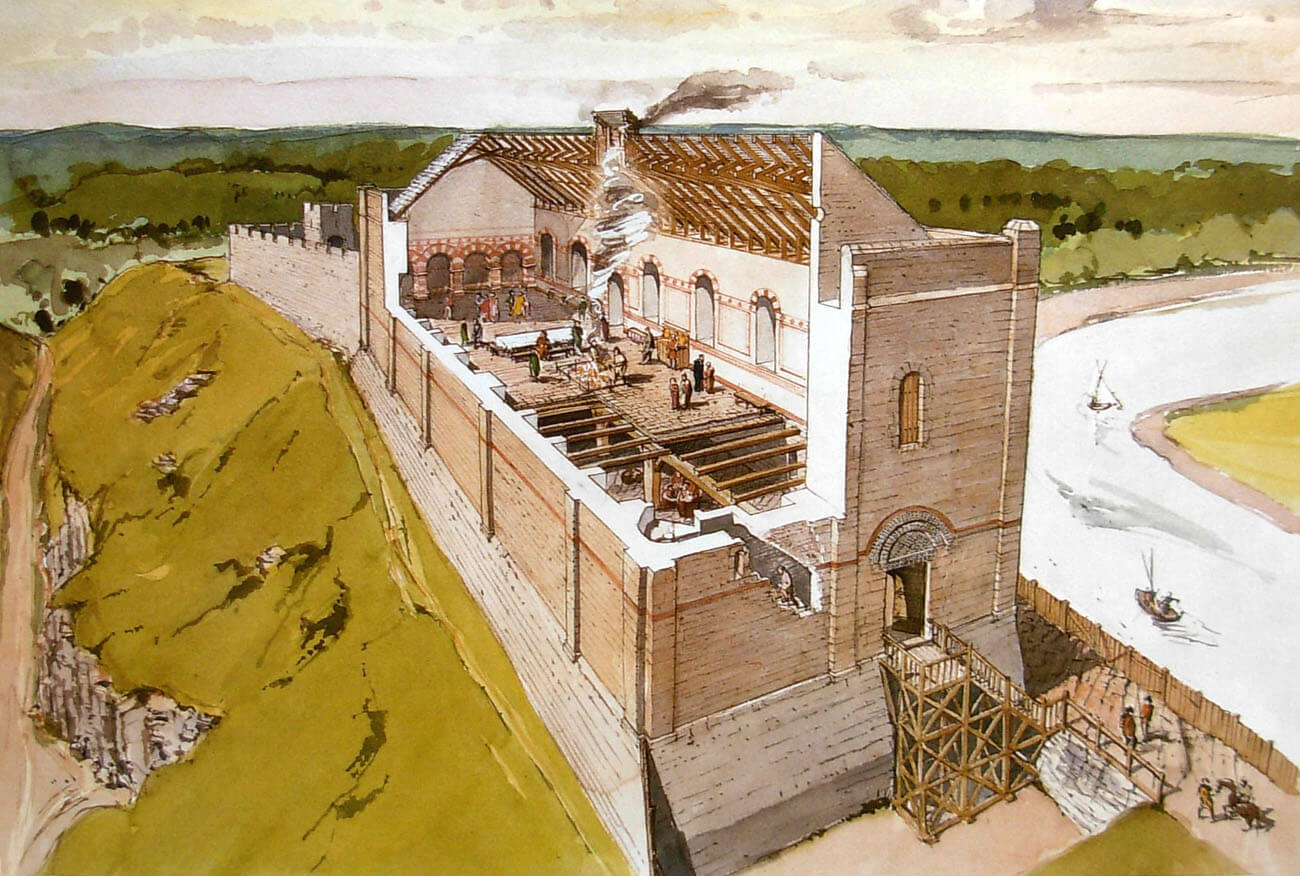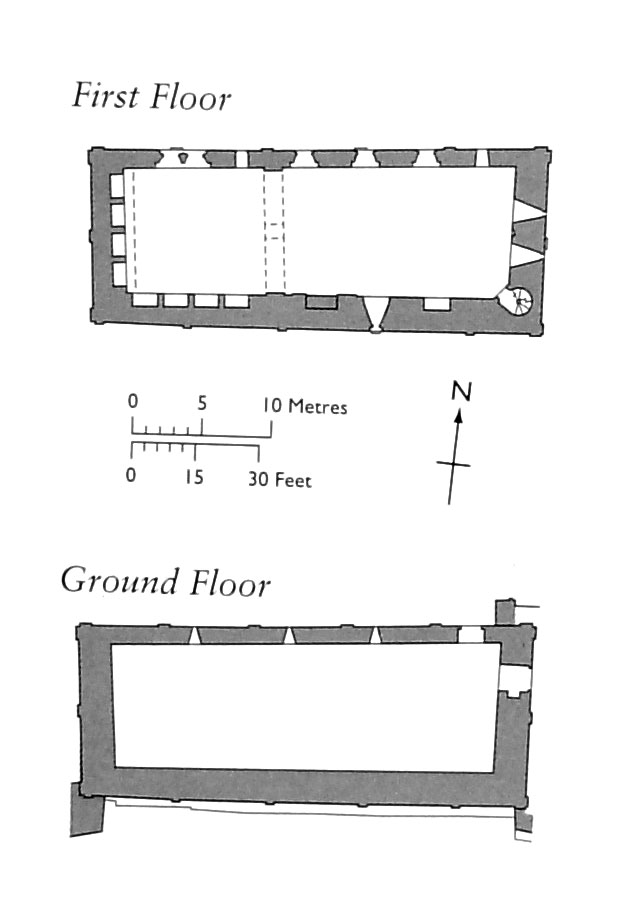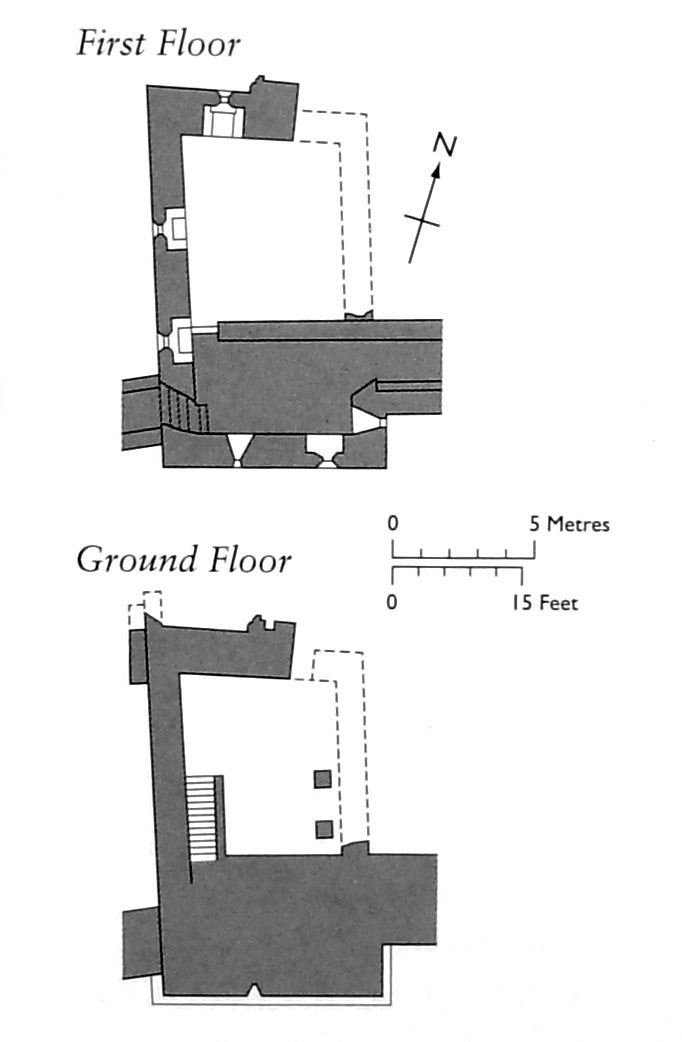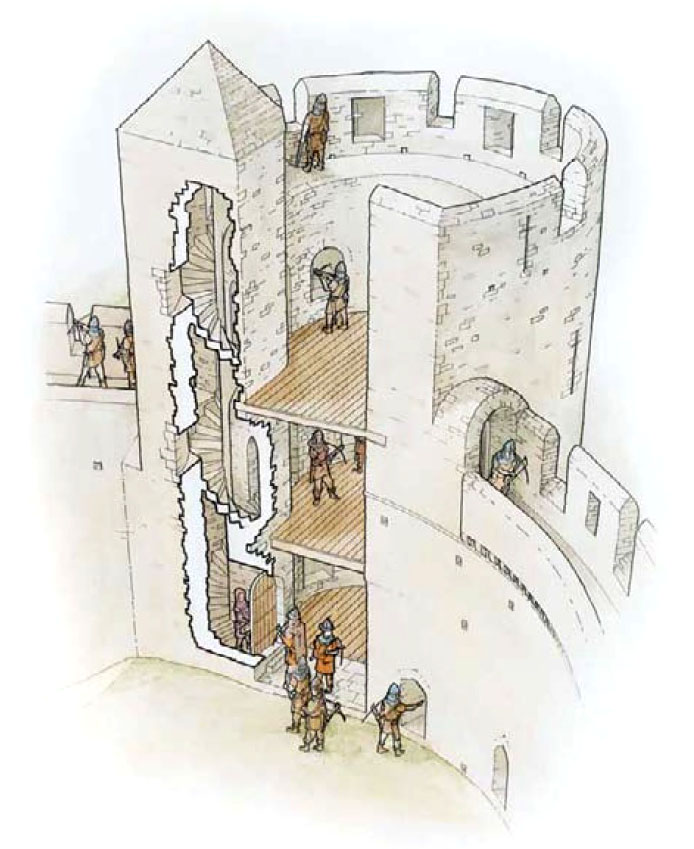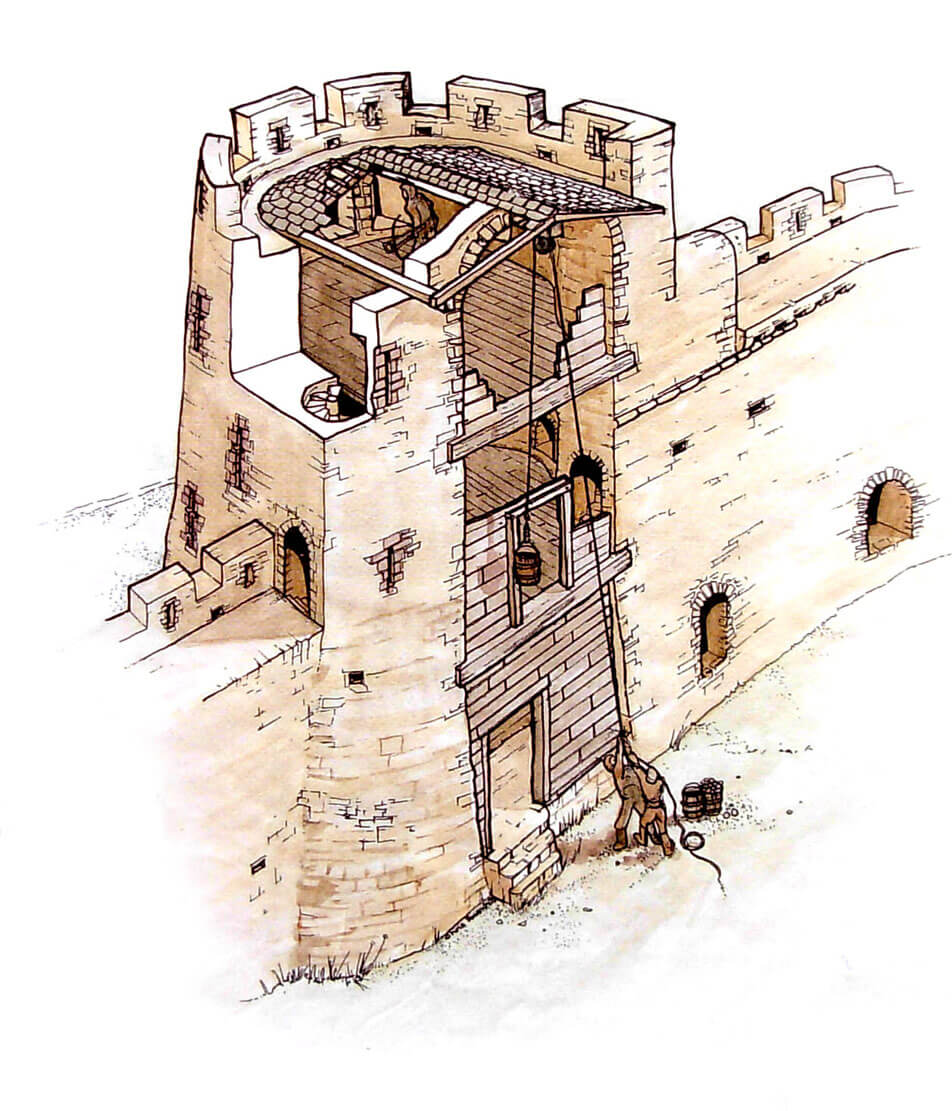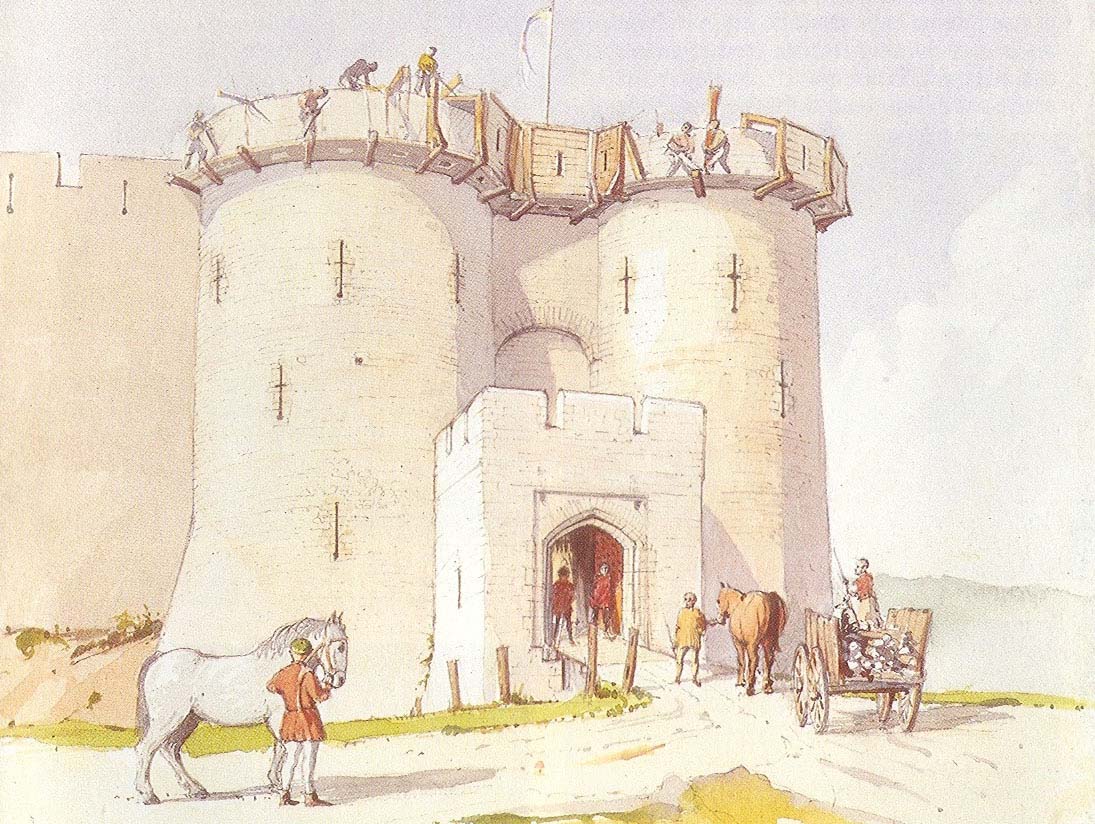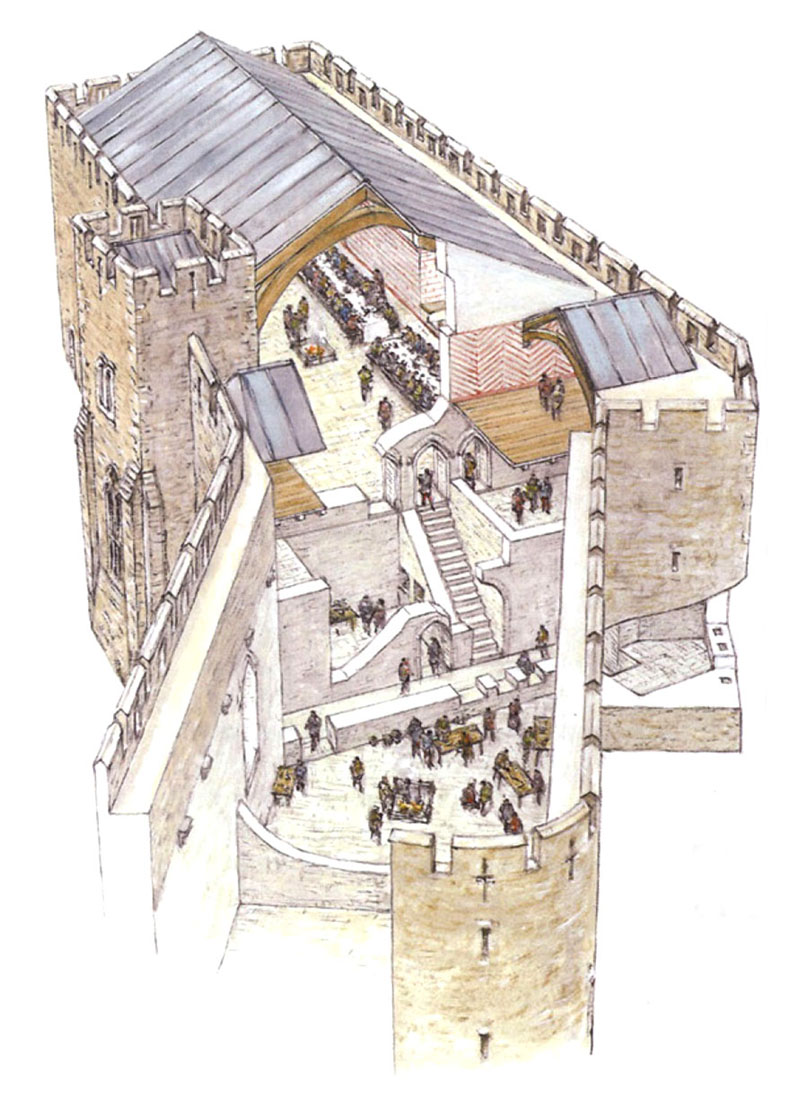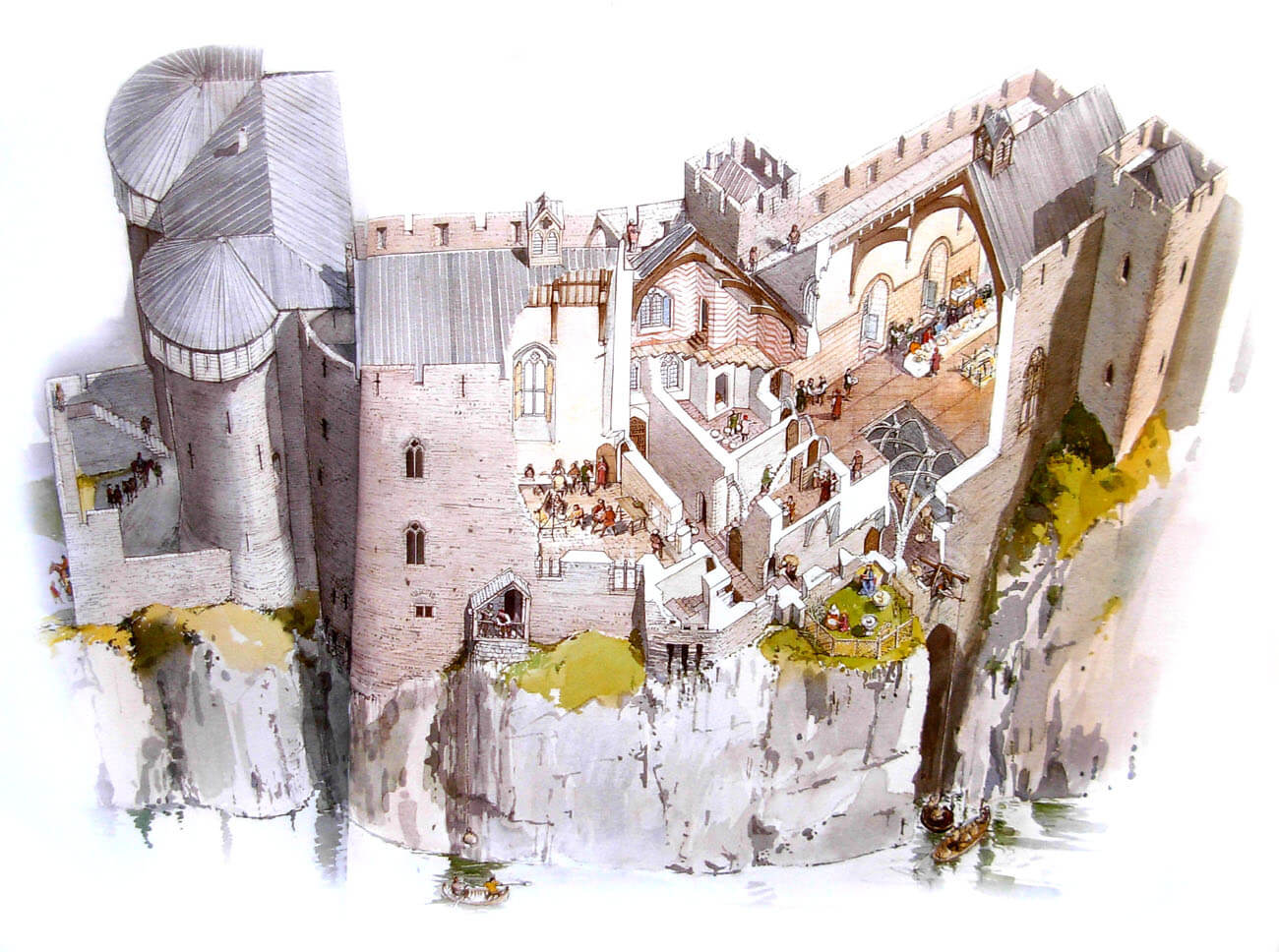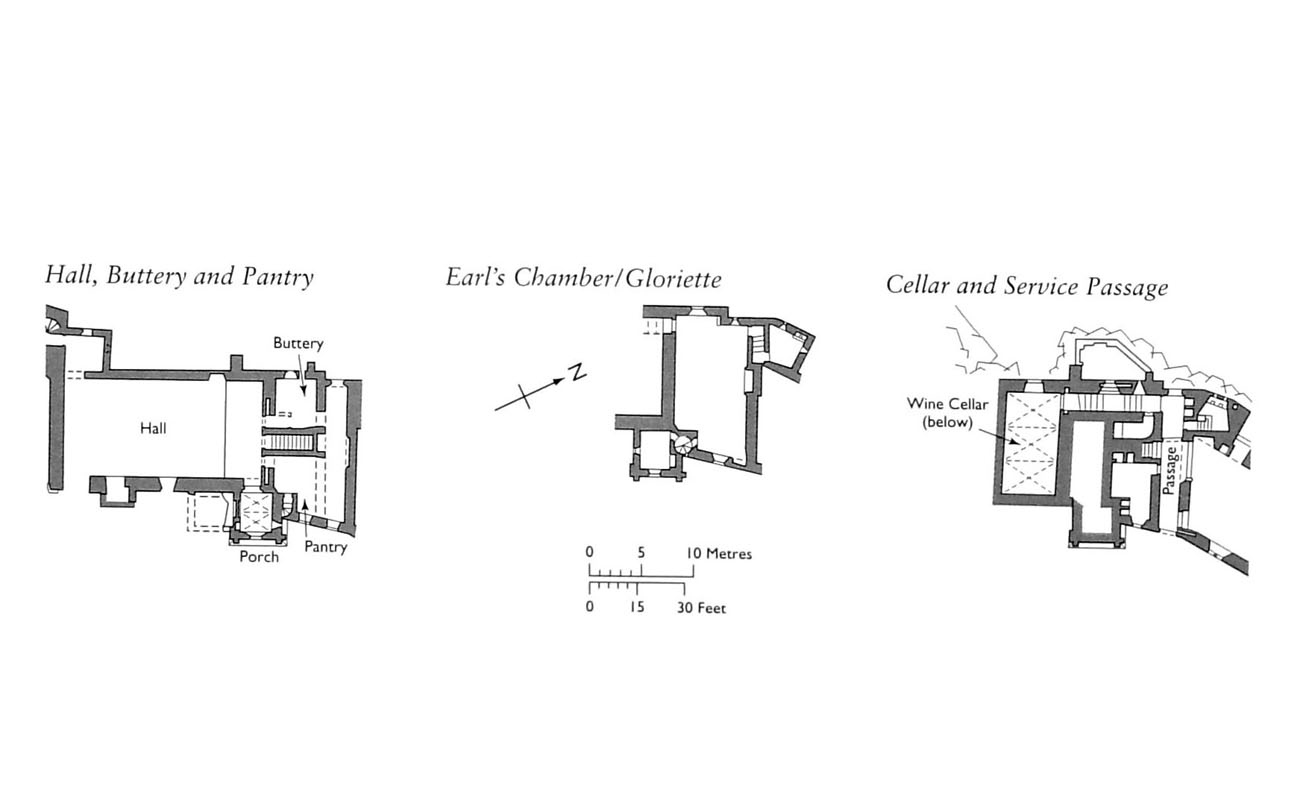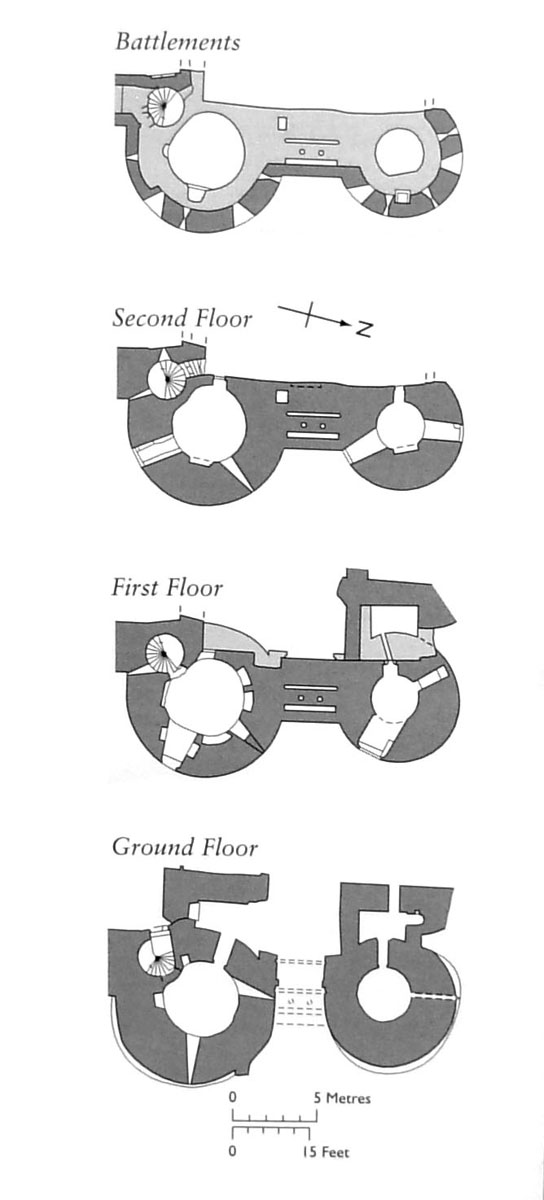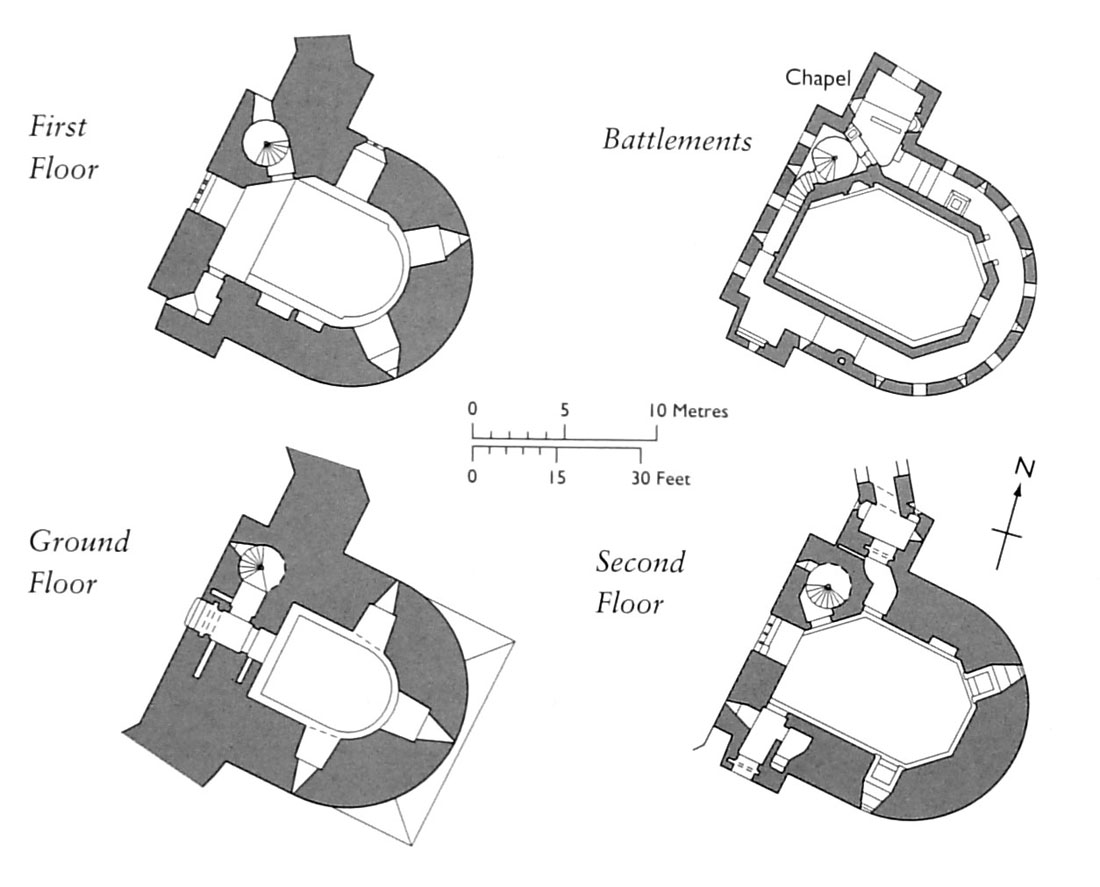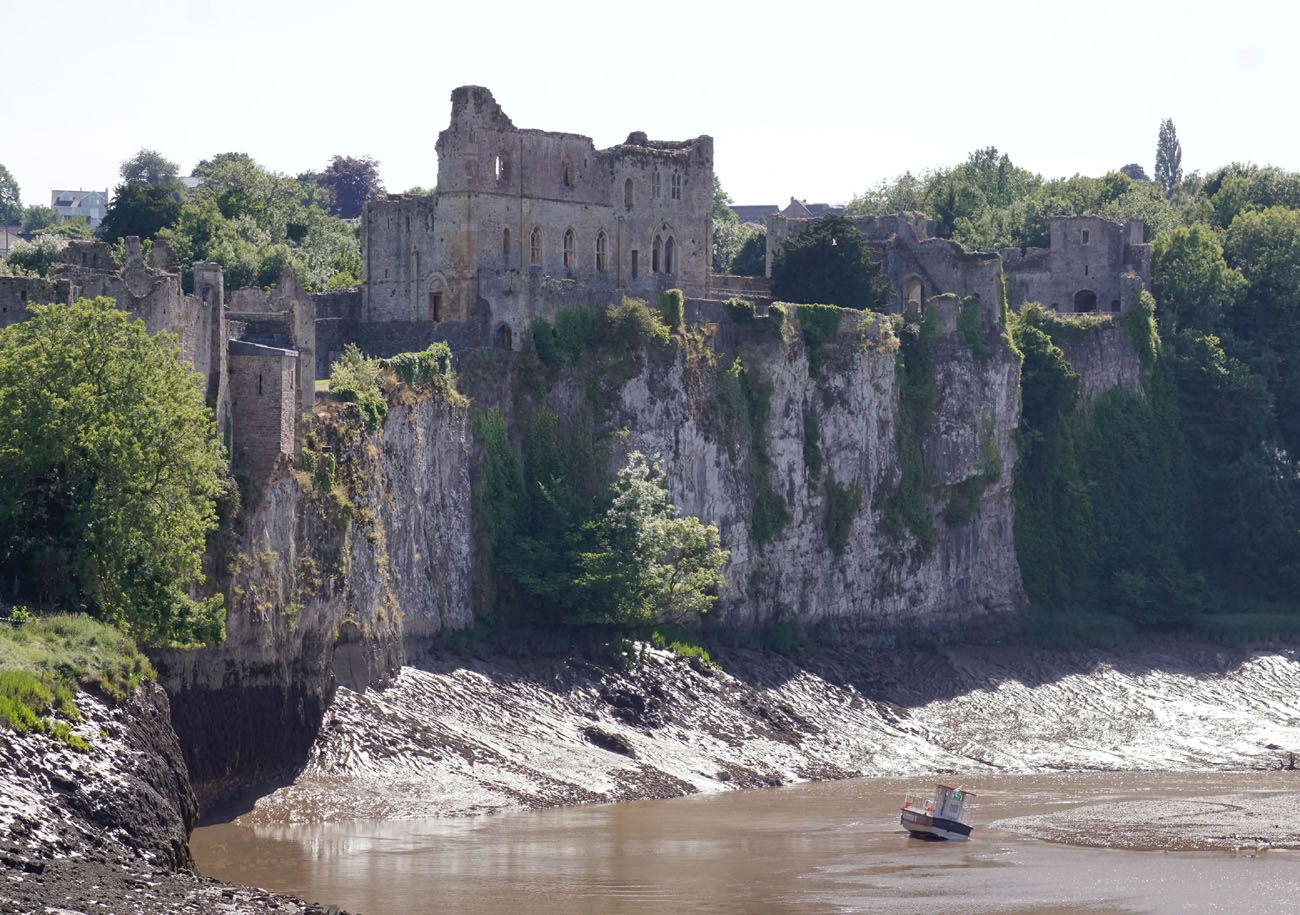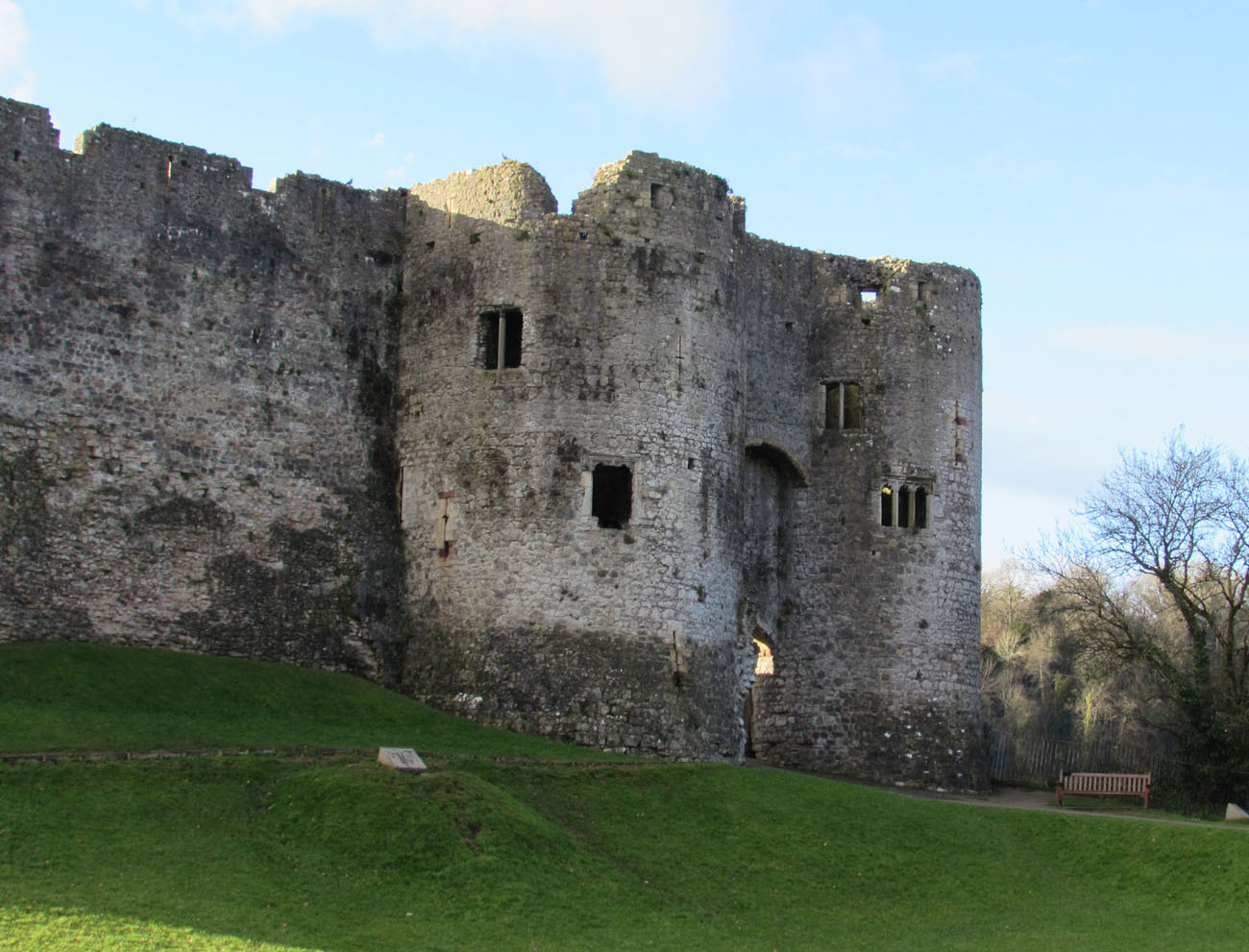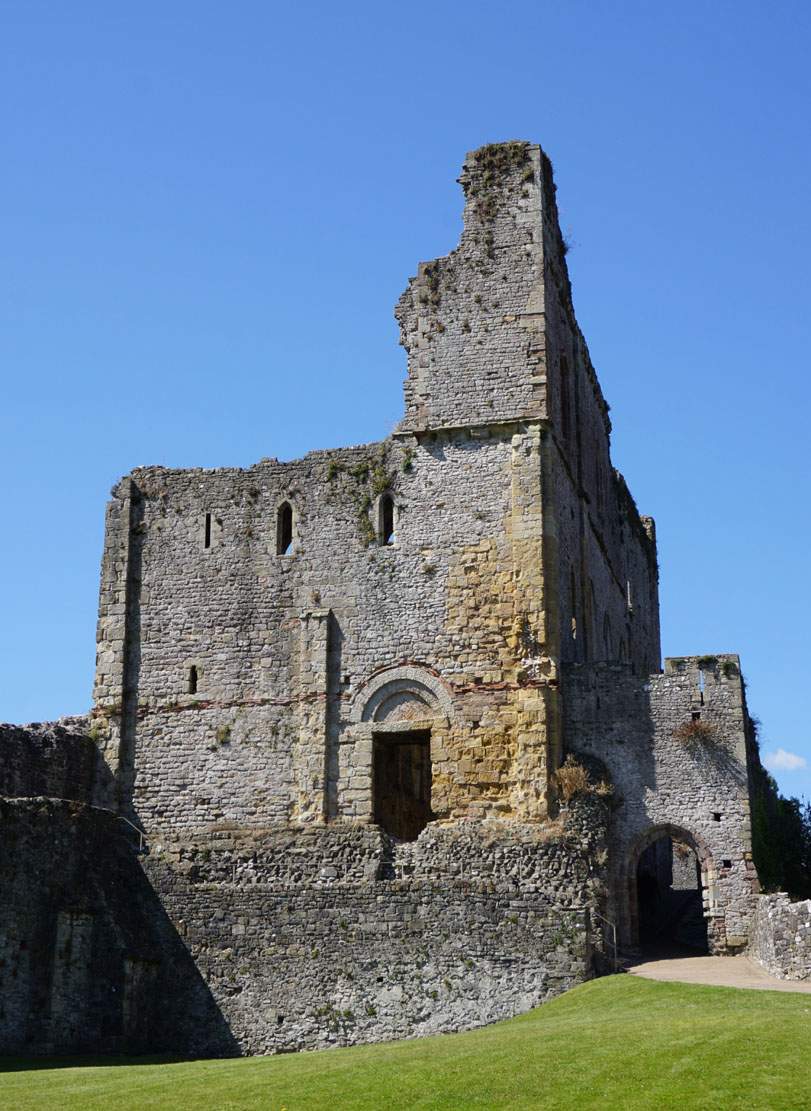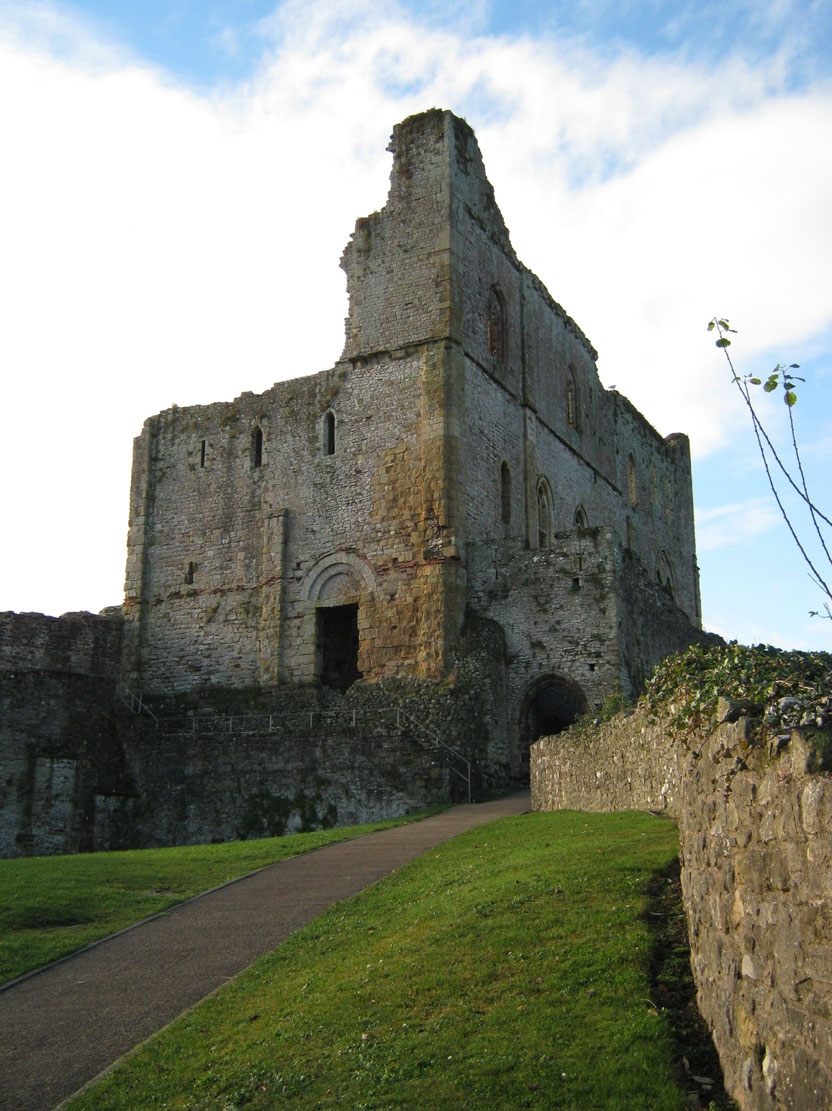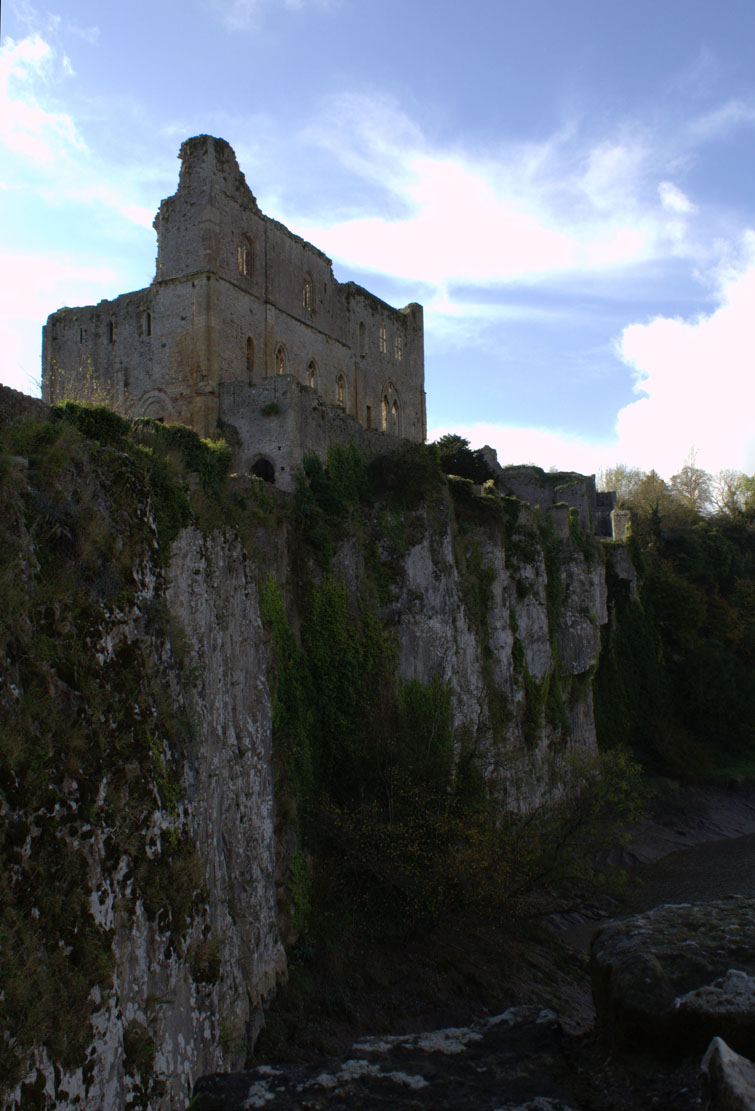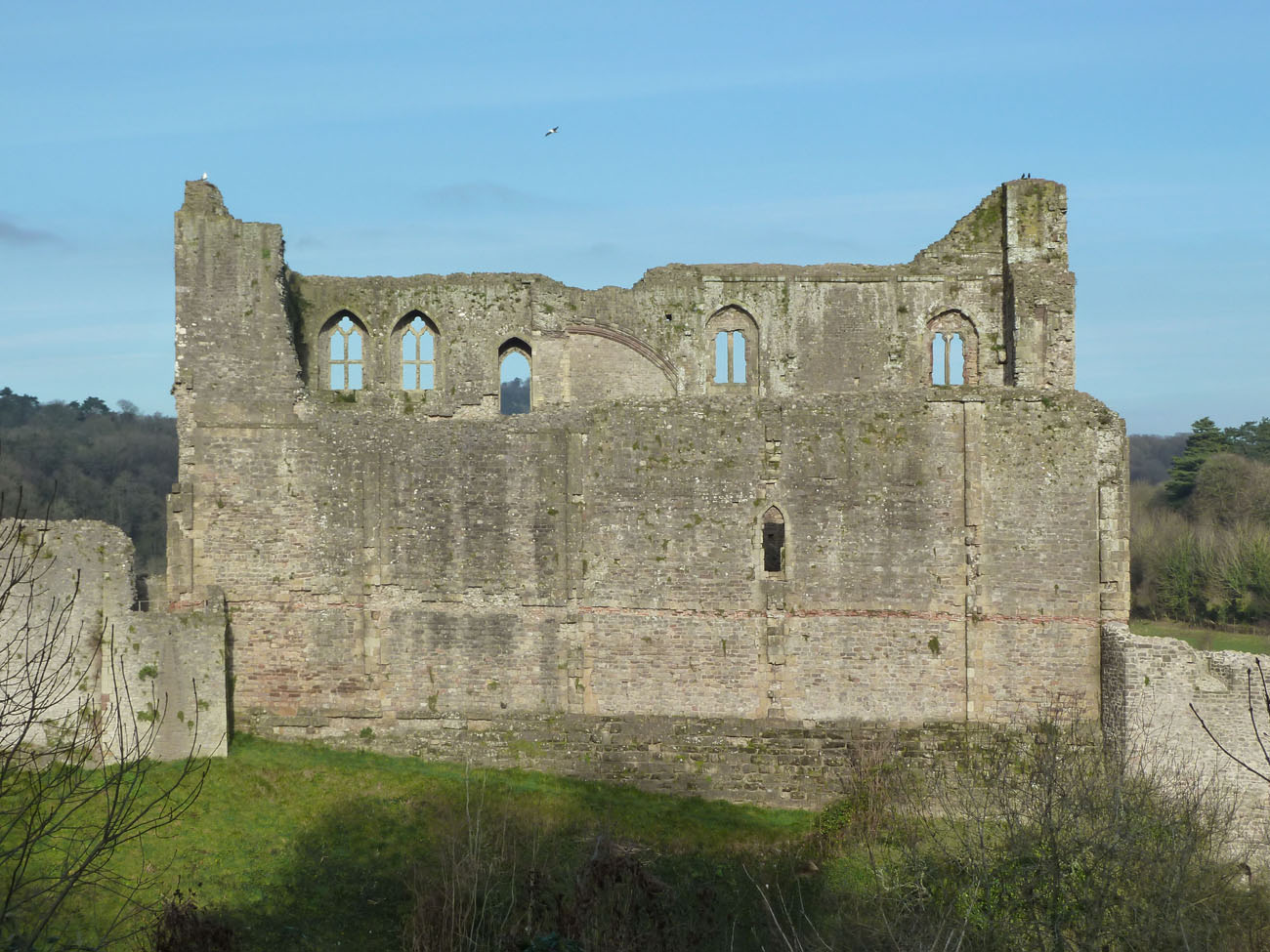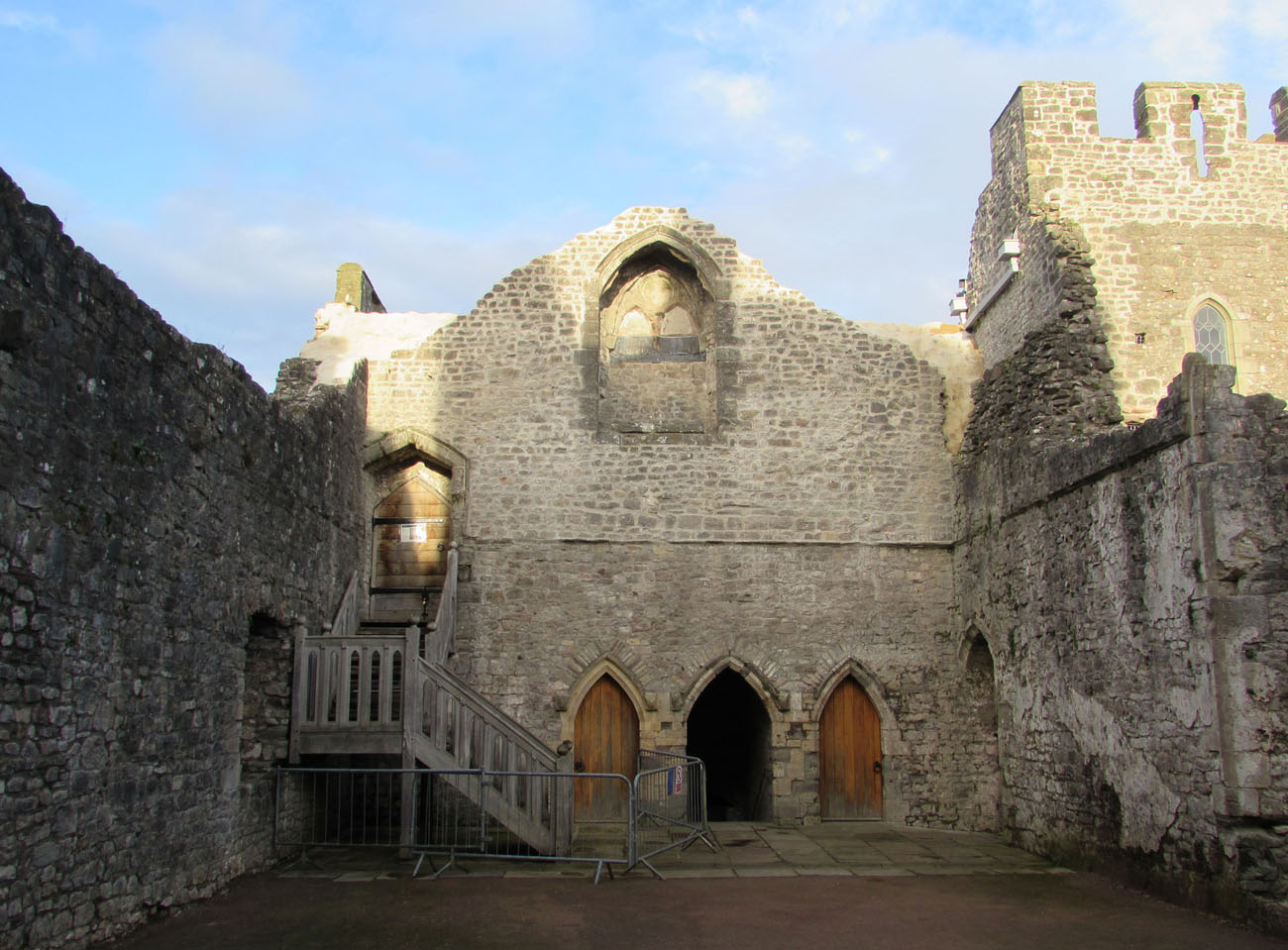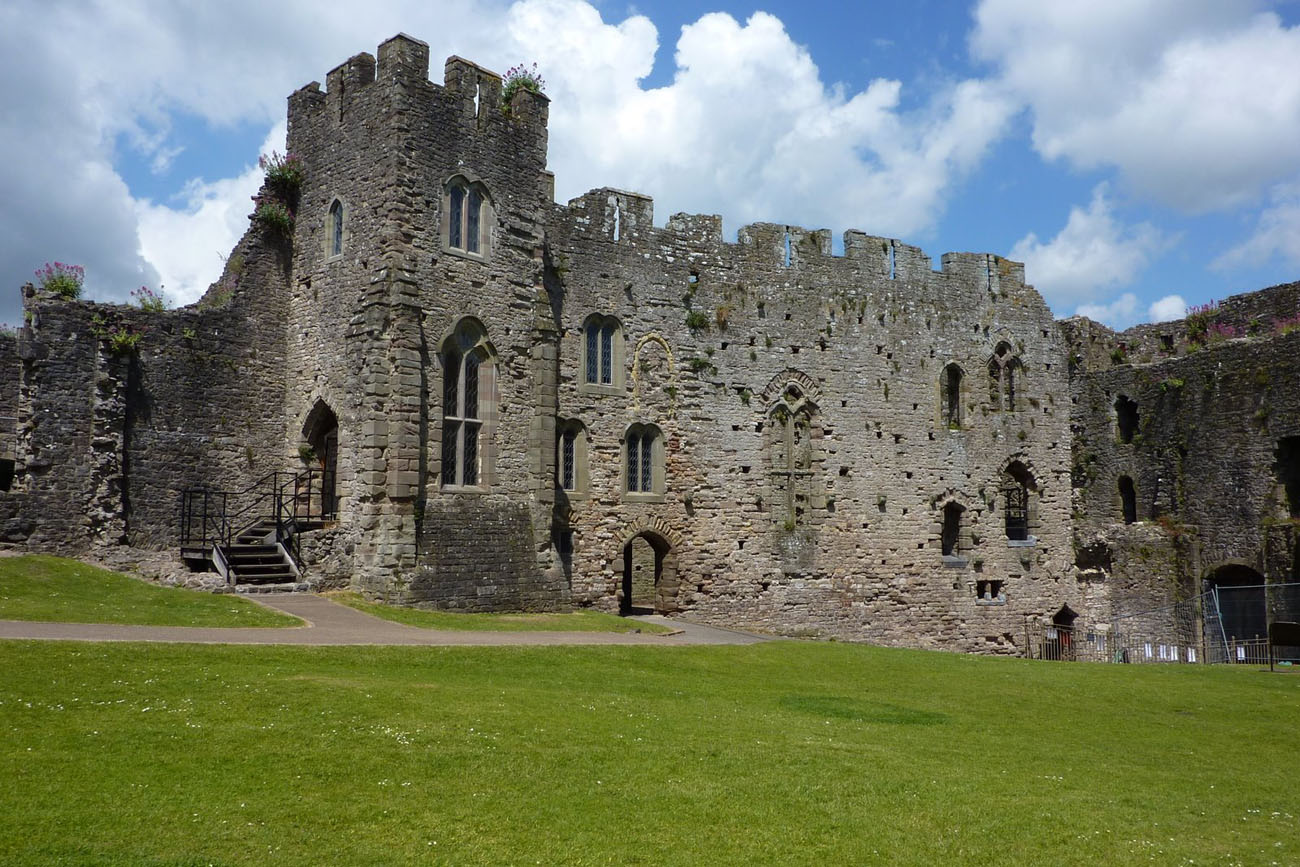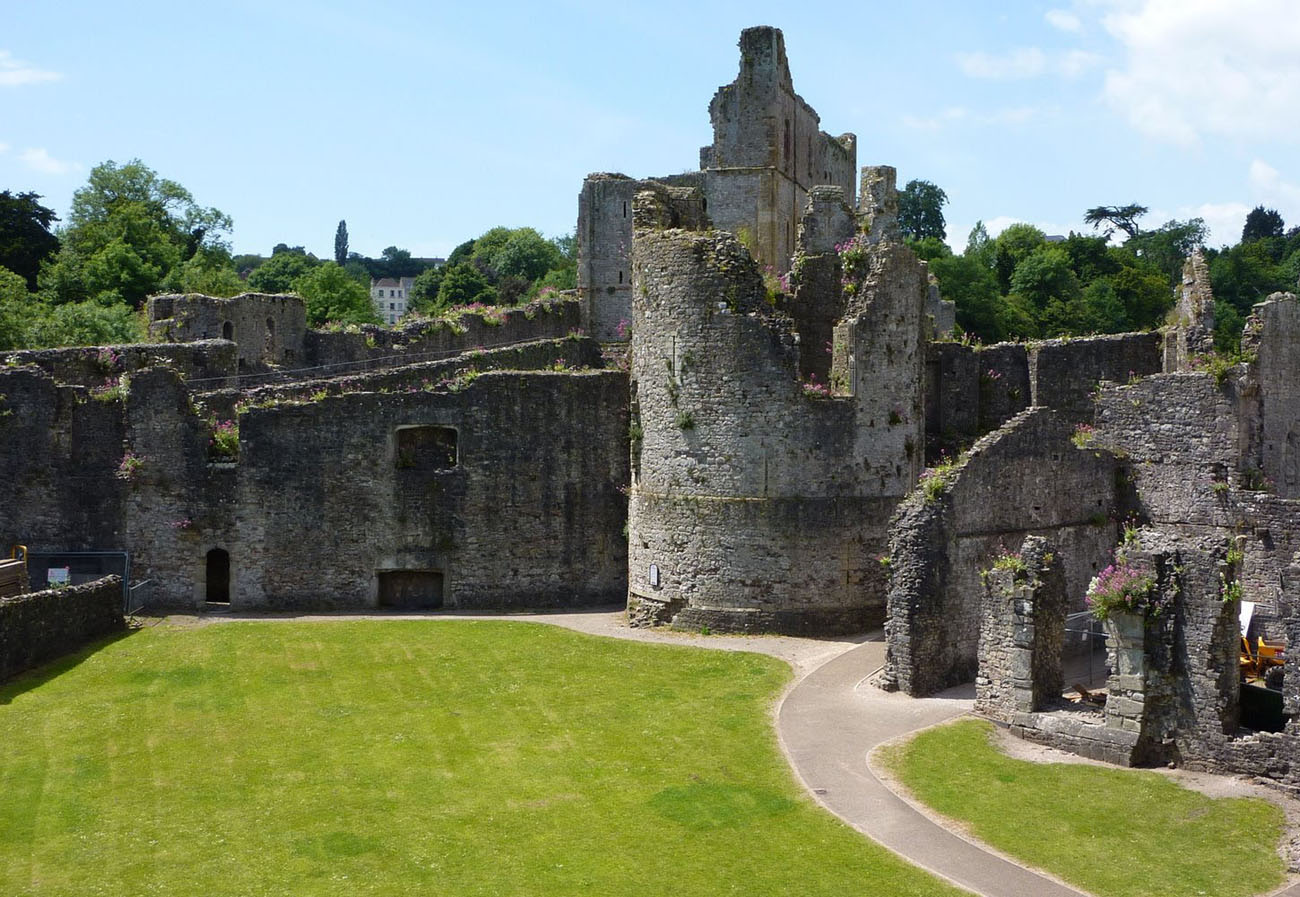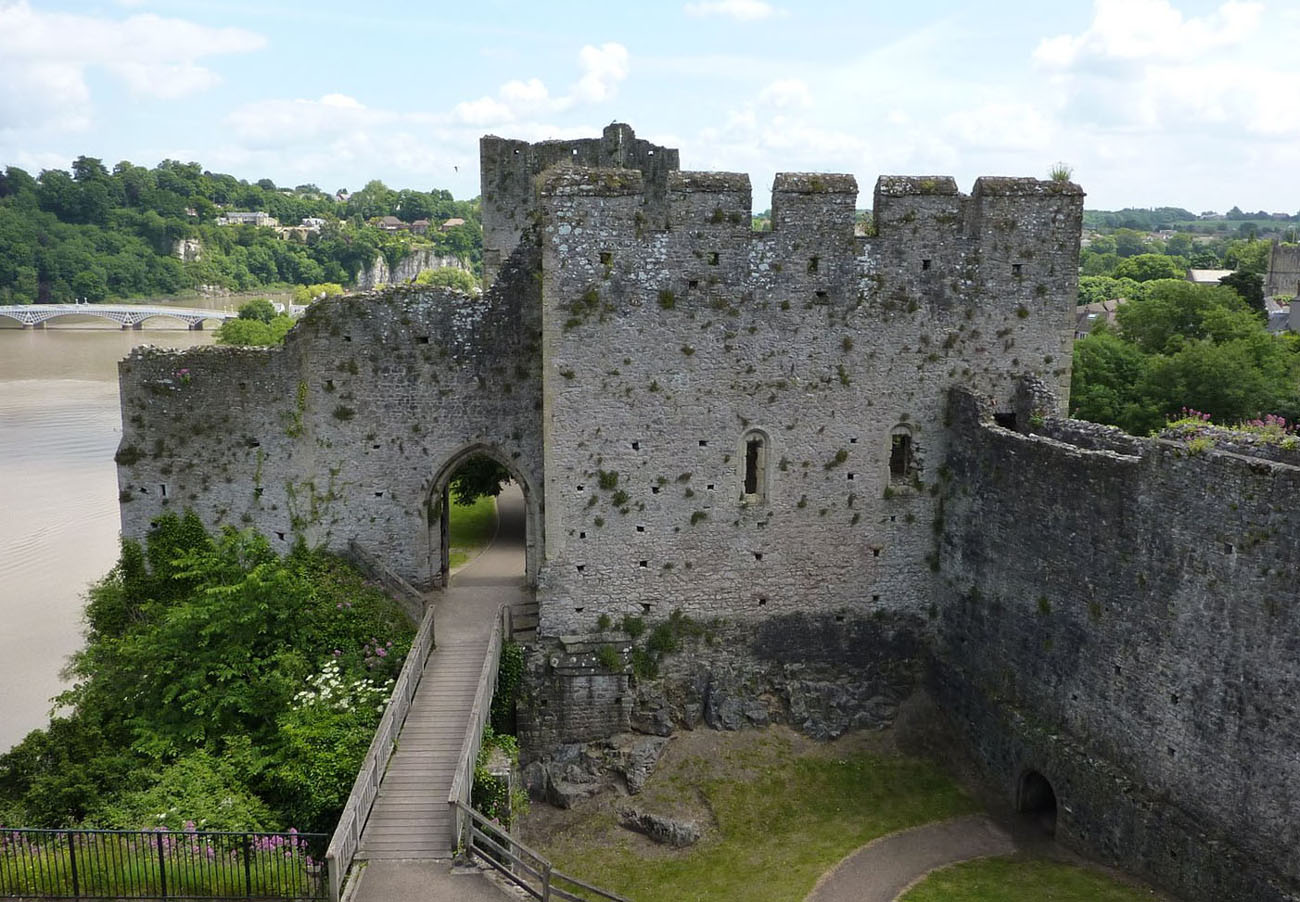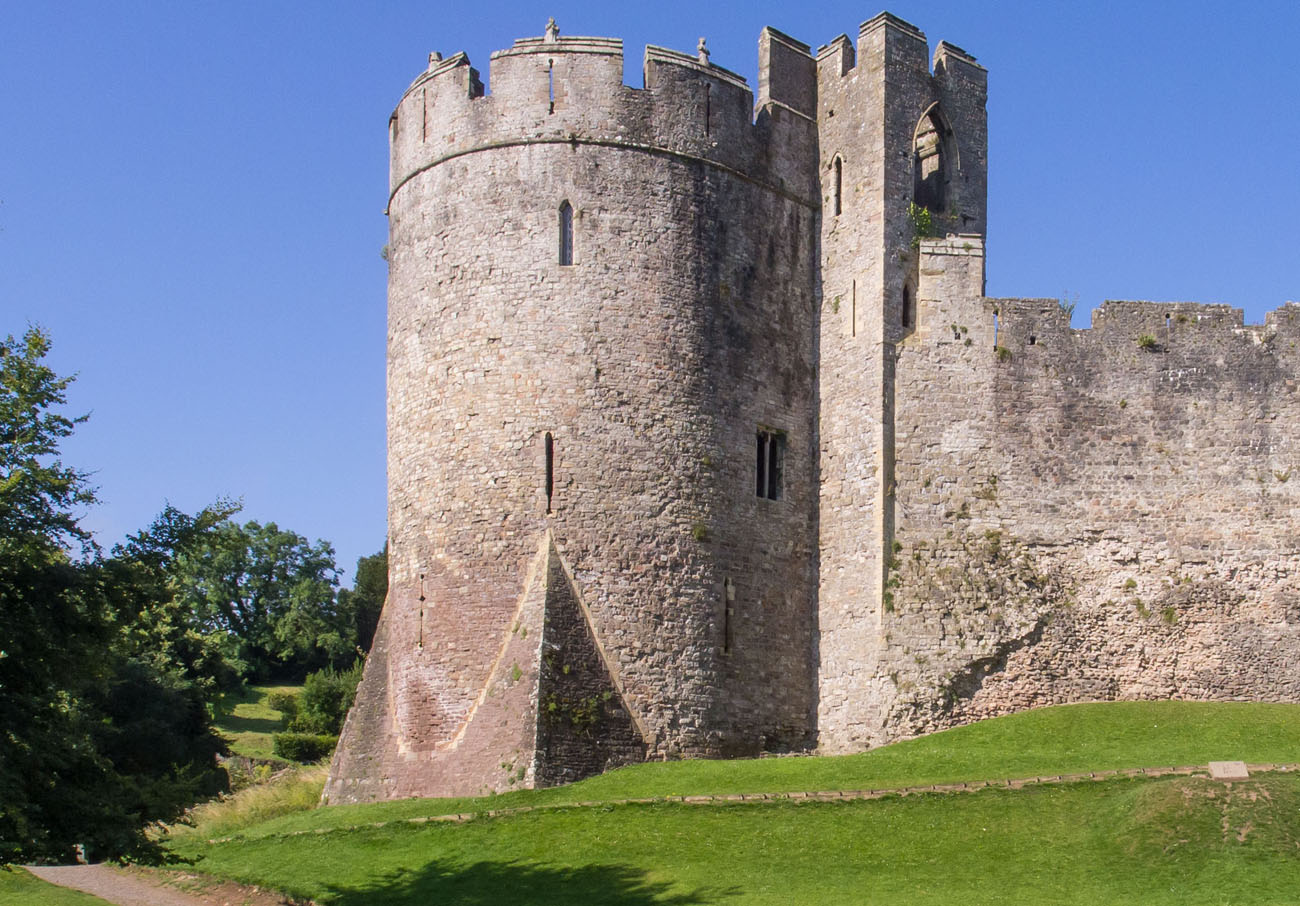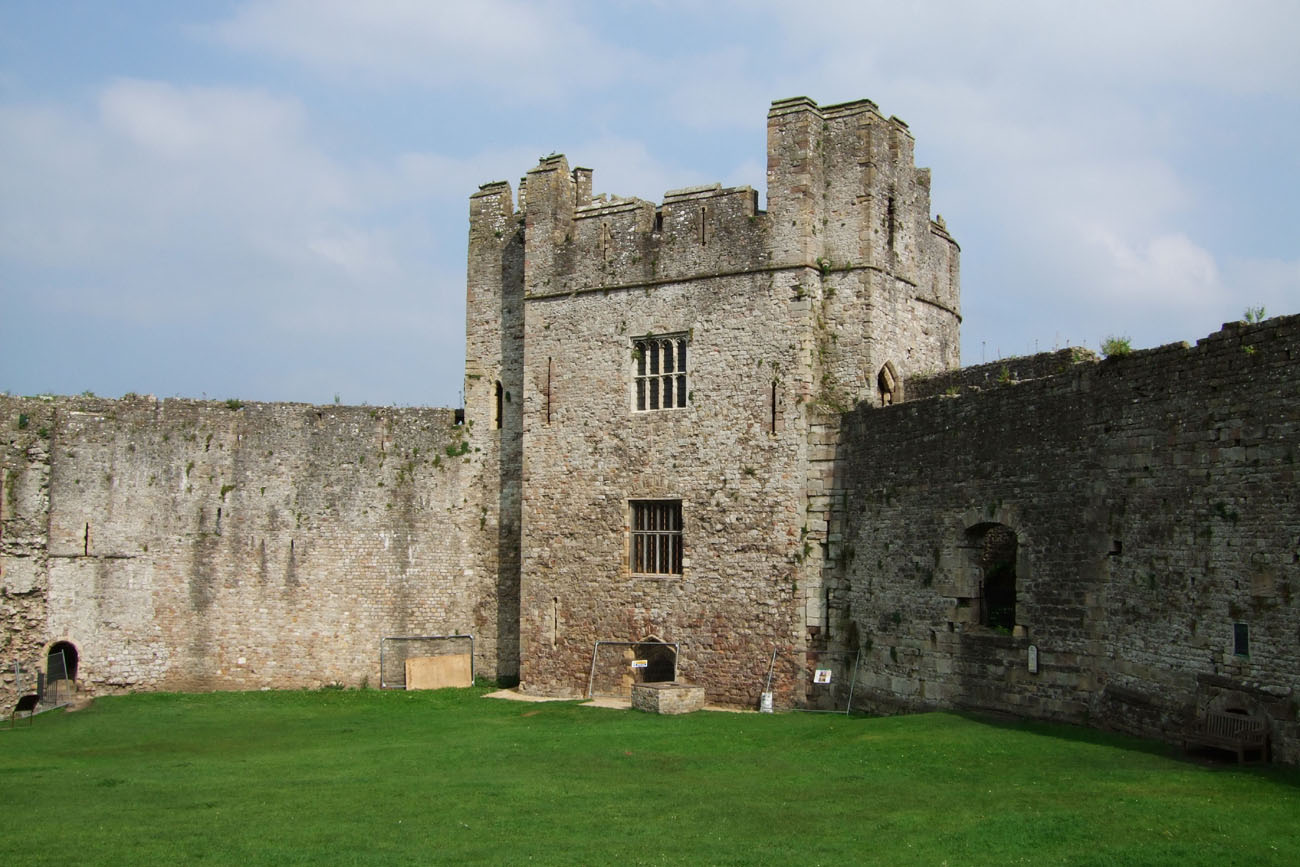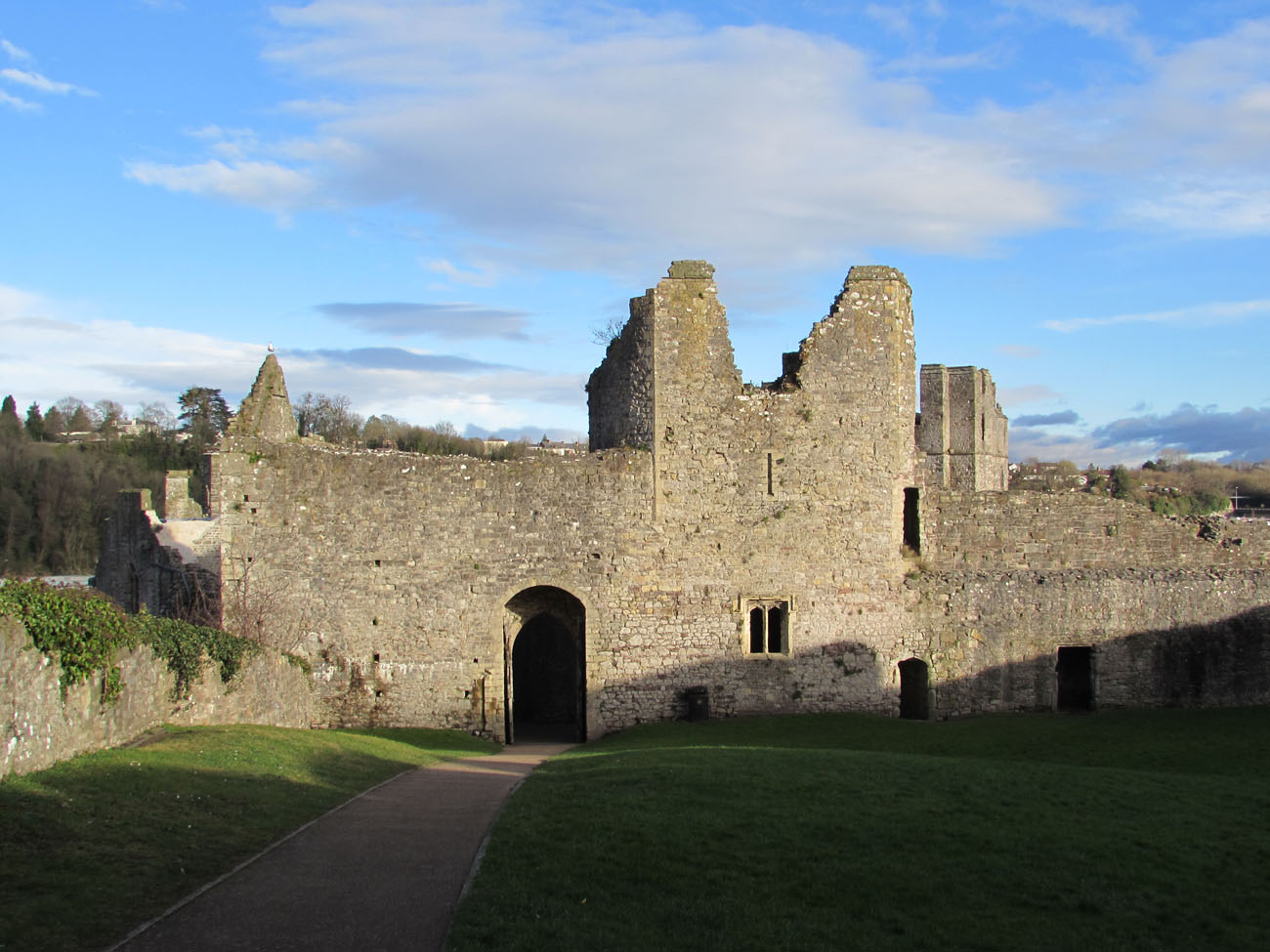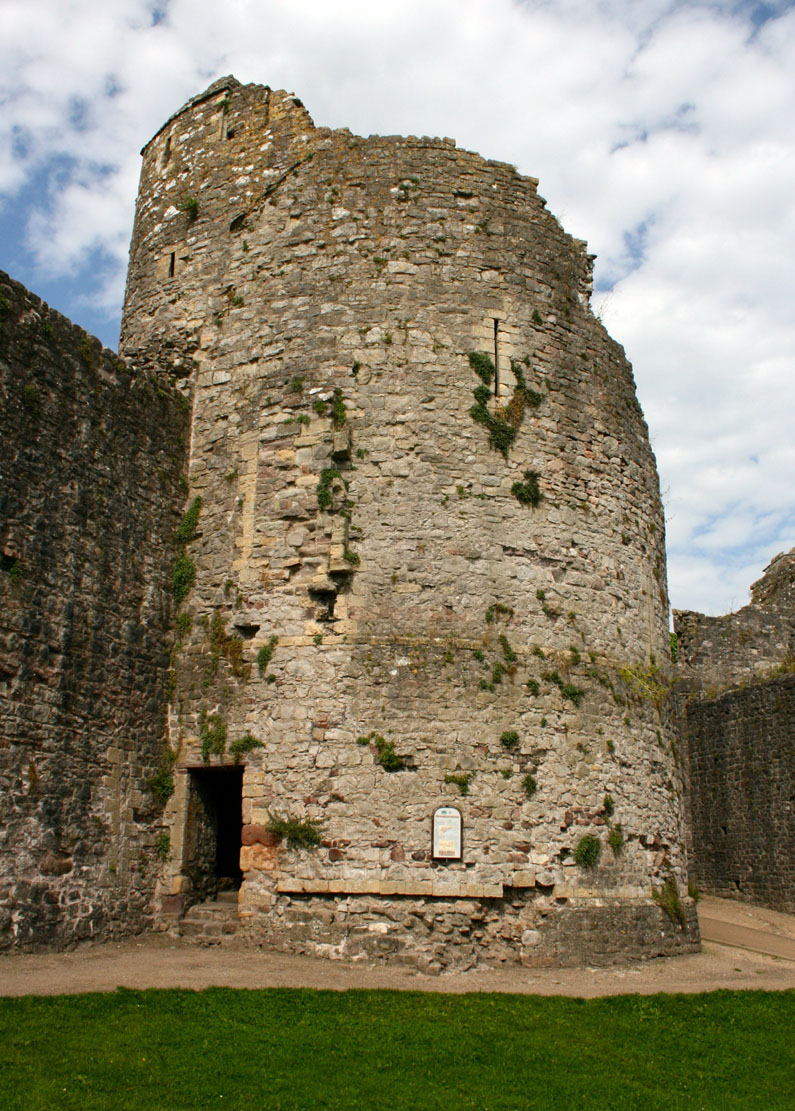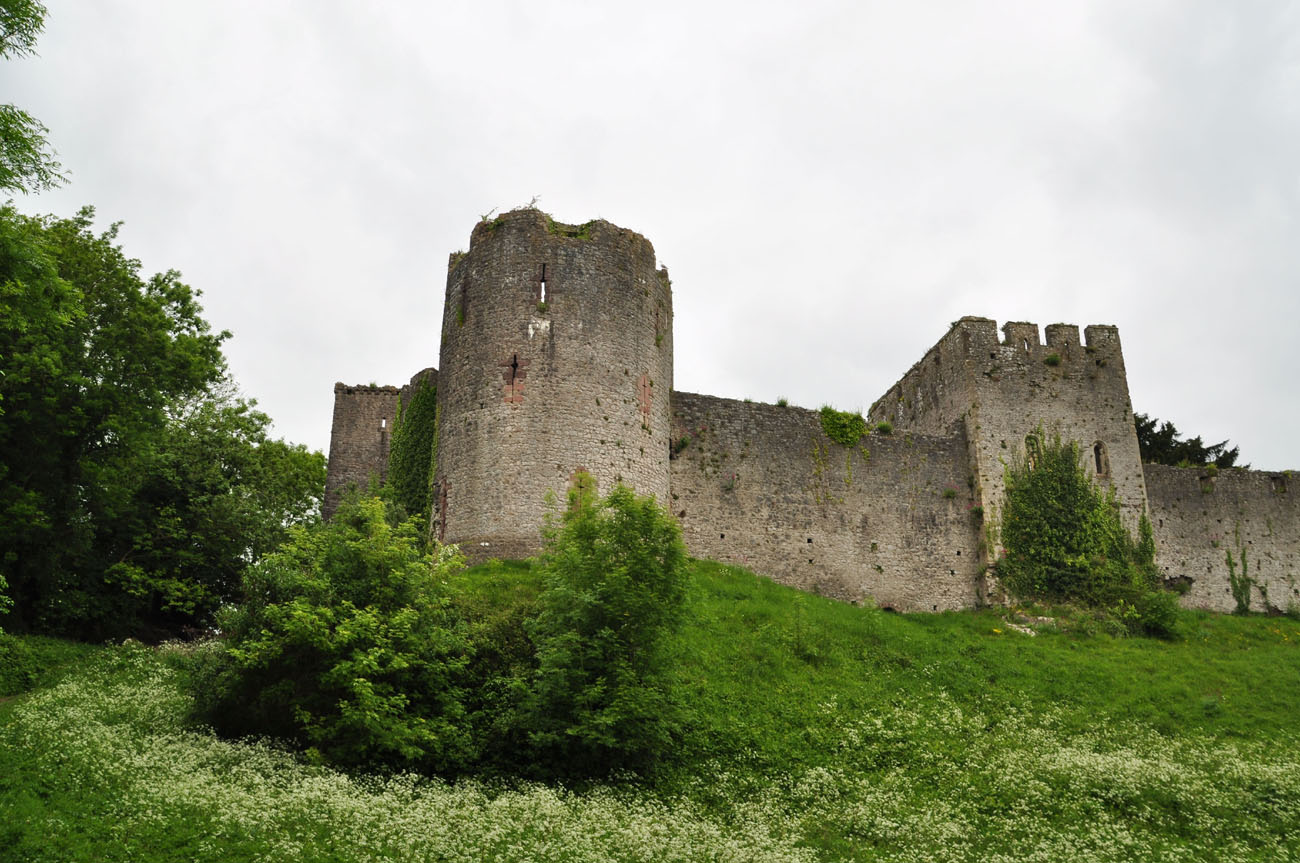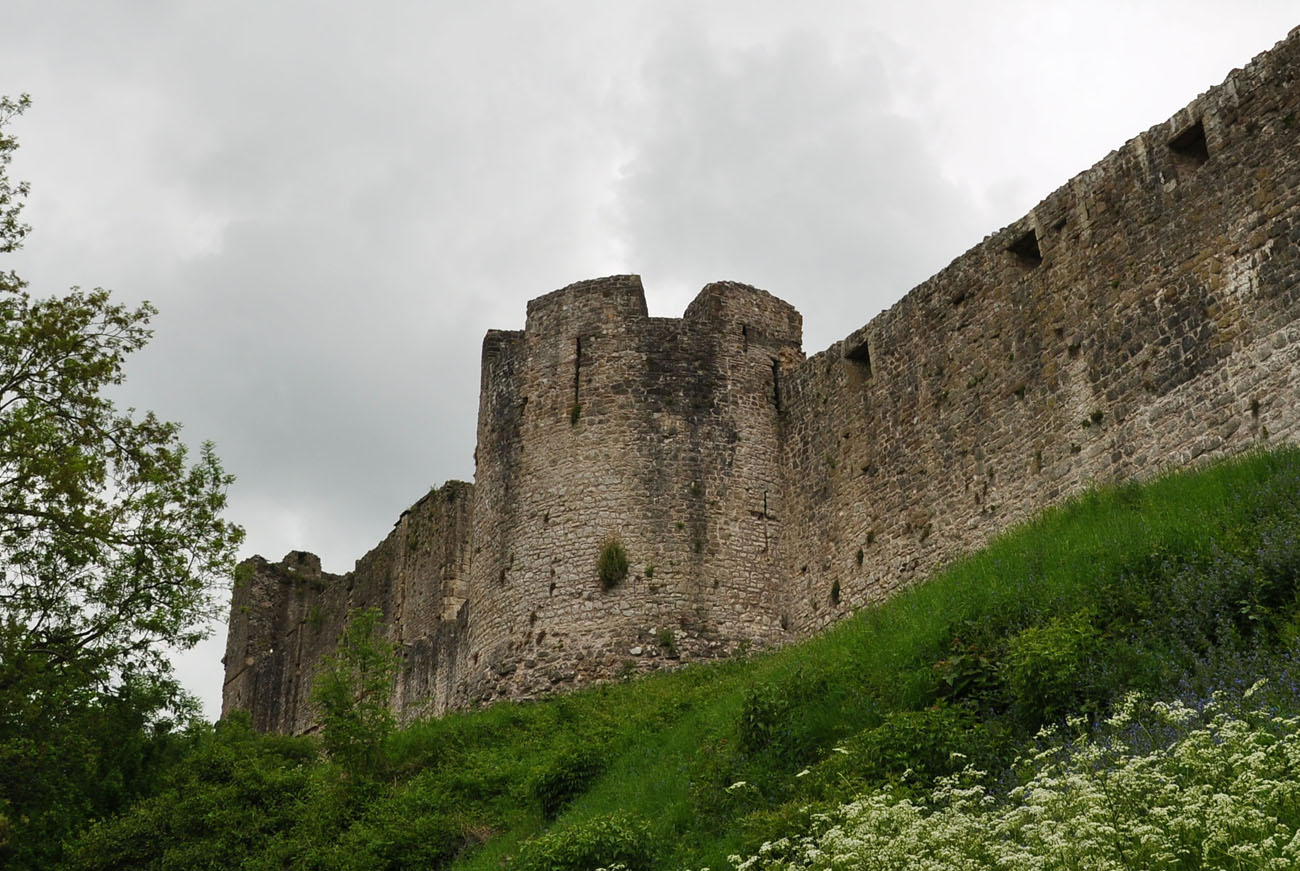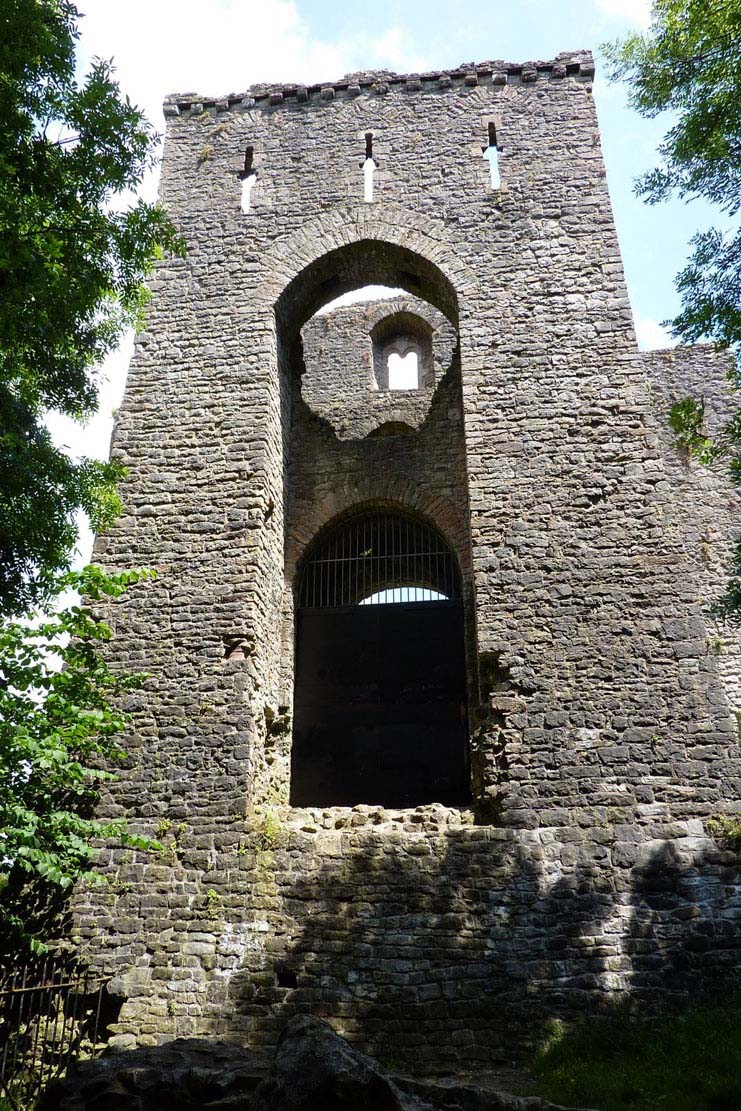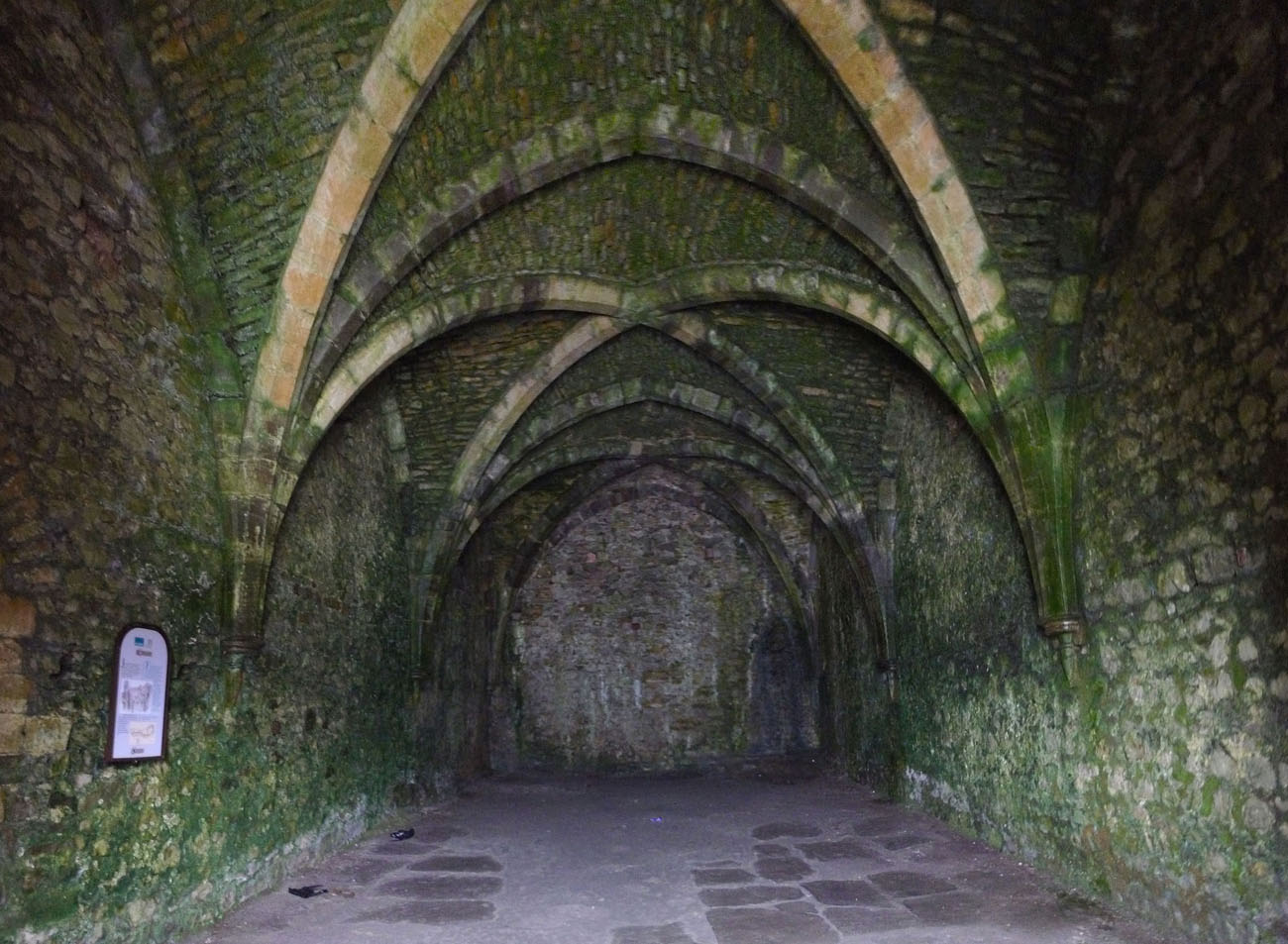History
The construction of the castle began Earl of Hereford, William FitzOsbern, on the order of king William the Conqueror around 1067. The stronghold, originally called Striguil, was to secure the south-western part of the border and suppress the threat from the Welsh. FitzOsbern also built a number of other castles along the River Wye (Monmouth, Hereford), thanks to which this important route provided the Normans with total control and maneuverability throughout the region. The Great Tower – the keep of Chepstow castle, was completed until 1090 and as one of the few from the very beginning, it was built of stone, not wood. Although most of the stones were excavated from local quarries, some of the blocks were reused from the Roman ruins at Caerwent. The short rule of FitzOsbern and his son in Chepstow and the architectural elements of the Great Tower (eastern tympanum, arcades of the upper chamber) lead to the assumption that King Wilhelm himself had a greater share in its construction than the FitzOsberns. He personally visited Chepstow in 1081, while marching through South Wales to St Davids, which was a pilgrimage and show of royal strength.
William FitzOsbern died in 1071 in the battle of Cassel, and his son, Roger de Breteuil, who inherited extensive property, lost everything when he took part in the attempt to coup against king William in 1075. Chepstow, along with other FitzOsbern castles, was taken over by the Crown, until in the early twelfth century it was ruled by the de Clare family. Namely, in 1115 Walter fitz Richard de Clare received the lordship from King Henry I. Further development of the castle was associated with William Marshal, Earl of Pembroke from 1189, who, after marriage with daughter and heiress of Richard de Clare, became lord of Chepstow. William expanded and enlarged the outmodeled castle, drawing on knowledge gained in France and crusades. He fortified the central ward (middle bailey), erected the main gate on the northeastern side, and rebuilt the fortifications of the upper bailey. Further work on the expansion of the castle was undertaken by the sons of William Marshall: William, Richard, Gilbert, Walter and Anselm. In 1228, William Marshall II received 10 oaks from the king, probably for the purpose of developing the keep. After his death, three years later, another brother, Richard, did not have much opportunity to expand the castle because he quarrelled with the king and had to flee to Ireland, where he died in 1234. Gilbert regained royal favour and was gifted 50, and later another 25 oaks probably to modernize the western part of the castle. He died in 1241 due to injuries sustained during the tournament in Ware in Hertfordshire.
The male’s Marshall family line ended in 1245, and their vast estates were divided among different descendants. Chepstow passed to William’s eldest daughter, Maud, who married Hugh Bigod, the Earl of Norfolk. Their son, called Roger Bigod, took the title of Earl and ruled Chepstow until 1270. However, he preferred his estates in East Anglia and nothing indicates that he would carry out any construction works in Chepstow. Only when the goods passed into the hands of his nephew, the fifth Earl of Norfolk, also named Roger Bigod, significant investments were made in the castle. During this period, new buildings were erected at the lower ward, which served as the main residence of the Bigod family. Roger Bigod, younger, also built a new tower after 1284, later known as the “Marten’s Tower”, and rebuilt the keep, or the Great Tower, at the end of the 13th century. At the end of the work, master Reginald was to construct four ballists and pay the carpenter to build a giant crane to mount them on top of the keep.
Roger Bigod the younger, died childless in 1306, and the castle returned to the English Crown. In 1312 Chepstow received from Edward II his half brother Thomas Brotherton. From this period comes a number of documents certifying numerous repairs and supplying the castle with a garrison consisting of twelve knights and 60 footmen. Chepstow remained a royal property until 1324, when Edward II granted it to his unpopular favorite, Hugh Despenser. However, only two years later, Edward’s authority was overthrown by a successful coup d’état led by queen Isabel and Roger Mortimer. Edward II and Despenser retreated to the Chepstow castle, but did not risk a siege and escaped. Both were finally captured, Despenser was executed and the king overthrown and imprisoned.
From the fourteenth century, and especially after the end of the wars between England and Wales at the beginning of the fifteenth century, the military significance of the castle was reduced. Still in 1403, it was on the initiative of the then owner Thomas Mowbray, Earl of Norfolk, garrisoned by twenty men at arms and sixty archers in response to Owain Glyndŵr’s rebellion, but its great size and limited strategic importance contributed to the fact that it was not attacked by the Welsh. During the War of the Roses, the castle served only as a refuge for Richard Woodville, Erl Rivers and his son after the defeat at the Battle of Edgecote. Their rival, Earl of Warvick, “Kingmaker,” besieged Chepstow, but the garrison surrendered without a fight, and Woodvilles were later executed. For the rest of the 15th century, Chepstow was part of the estate granted to William Herbert, Earl of Pembroke, and in 1508 it became the property of Sir Charles Somerset, the later Earl of Worcester who rebuilt the castle in Tudor-style, into a more comfortable residence.
In the 17th century, during the English Civil War, the castle was occupied by royalist troops. They dominated in Wales at the beginning of the conflict, but in 1645 parliamentary forces under the command of Thomas Morgan besieged Chepstow. After the castle was fired, the garrison gave up. The stronghold escaped slighting, but in 1648 it was again occupied by royalists of Nicholas Kemeys. The forces of Parliament led by Oliver Cromwell again shelled the stronghold causing significant damages. The garrison gave up and Kemeys was executed. After the war, the castle was garrisoned and was maintained as a barracks and political prison. The prisoner in Chepstow was, among others, Henry Marten, one of the commissioners who signed the death sentence on king Charles I, held until his own death in 1680. In 1682, the castle became the property of duke Beaufort, the garrison was withdrawn three years later and the buildings were partially demolished, rented to tenants or left to their fate. The first repair work was undertaken at the beginning of the 20th century.
Architecture
Chepstow Castle was founded on a narrow and longitudinal ridge between the limestone cliff above the River Wye from the north and the Dell Valley from the land side, from the south. The bend of the Wye that ran a few kilometers down into the estuary of the River Severn flanked the area to the east. The first buildings were erected at the highest point of the area between two ditches, probably created by widening natural rock crevices. A well-protected area measuring 85 x 20 meters was thus fenced off.
The oldest part of the castle was the so-called Great Tower, that is an elongated, rectangular, stone building of the donjon function, which dimensions were 36 x 14 meters, and the height was originally about 10 meters (on the west side, where the terrain was higher). Due to the drop of the area, its eastern part was set on a massive pedestal, and the outer elevations were reinforced with pilaster butresses. The more endangered southern wall was more massive, it was about 2.6 meters thick, while the northern wall located above the escarpment was only 1.2 meters thick. In the first phase of the 11th and 12th centuries it was a two-floor building, with the lower storey accessible through the northern portal, and the upper level through wooden stairs from the east, leading to the portal with a romanesque tympanum decorated with the distinctive carved saltire pattern and the type of lobby, from which the main ceremonial chamber was reached through the passage in the thickness of the wall and the staircase. The second entrance to the first floor was probably in the north facade, where a timber staircase led directly. Illumination of the lower floor was provided only by three small openings, and the upper floor by seven semi-circular windows from the safer side facing the river. The eastern facade also had small windows, while the southern and western walls were deprived of them for security reasons. Originally, each floor was filled with single, spacious chambers, separated by a wooden ceiling, which transverse joists rested on holes in the longitudinal walls and on a single, massive beam fixed in the nests of two shorter walls, supported from below by wooden poles. The main, upper hall on the south and west sides had rows of arcades with semicircular finials in the walls, with the central southern arcade larger. Originally they were plastered and decorated with white and orange patterns. The lower storey originally served as a pantry and warehouse, and since the fourteenth century as the armory. The upper one was rather unusual – it did not have a fireplace for heating, latrines, a division into private, smaller rooms, or, except the northern portal, passages for servants. For this reason, it is supposed that this was not a typical great hall, but rather a representative chamber intended for judicial function, with a place for the king in the central, largest niche on the south side. The keep’s defense was limited only to the guards gallery at the crown of the walls, most likely without a battlement.
In the years 1219-1245, the upper floor of the keep was rebuilt, piercing five new, gothic windows (three on the north side, one from the east and south), with benches in deep niches on the inner side facing the river, and private chambers on the west side were arranged. Each window was divided into two openings with finials in a trefoils below the quatrefoil tracery. Only the upper part of the windows was glazed, the lower was equipped with holes for fixing wooden shutters. The western part of the keep was also raised by another floor, supported on a single pillar with beautifully decorated arches falling on consoles with leafy forms. An additional storey with a private chamber was illuminated from the north by two ogival windows and connected by means of timber, external stairs. In the former large central niche on the main floor, a fireplace was arranged, thanks to which the keep could perform more typical residential and representative functions as the seat of a lord. In the years 1293-1300 Roger Bigod raised the remaining, eastern part of the keep, placing small turrets in its eastern corners, and covered the whole with a lead roof. The keep reached a height of 23 meters. From the side of the river Roger erected gallery, that is a covered porch running along the keep, constituting the connection between the middle and upper wards. Inside, it had a series of semicircular niches in the wall facing the river and an upper defensive walkway secured with battlement. Both ends: east and west, were closed with gates. When the porch was built, the external stairs leading from the north to the keep’s floors had to disappear. Probably they were then replaced by internal staircases. Below the porch, at the foot of the cliffs in the coastal mud, a cylindrical water tank was built to flow into it from a natural spring from the riverside rocks. This water was tapped using winch and buckets lowered on the ropes.
Adjacent to the Great Tower were two outer wards: the western one, also called the upper ward (measuring approximately 38 x 16 meters), and the eastern, which later became the middle ward. Between 1189 and 1245, the middle bailey was reinforced with two towers from the east: a three-story cylindrical one in the corner and a horseshoe tower. The third, slightly smaller, protruding completely in front of the face of the wall horseshoe tower was located on the southern side. The more massive, three-story eastern horseshoe tower was also extended beyond the face of the wall and flanked the gate, pressed between the riverside cliffs on the north side, which was a mere portal pierced in the wall. In the 16th century, the interior of the ground floor of the tower was transformed into a kitchen, assembling a fireplace and a bread oven in it. The upper floors still had defensive functions and were accessible only from the crown of the defensive wall. In the Middle Ages, the middle ward was probably not built-up, performing only defensive functions. Perhaps lords also did not want to reduce the dominance of the keep over the surroundings.
The upper bailey was the main courtyard of the 11th century castle, surrounded by two curtains of the wall with an entrance gate on the west side and protected from the north by inaccessible slopes. Around 1215, a four-sided residential tower was erected in the southwest corner, named after the founder the Marshall Tower. It housed a private chamber on the first floor and a kitchen in the ground floor. The upper chamber, known in the sources as “camera comitisse”, could have served William Marshall’s wife. It was well lit by five windows in deep niches and heated by a fireplace embedded in the wall from the courtyard side. The lower utility floor was equipped with an outflow for sewage with an outlet to the Dell Valley. In addition, on the opposite, riverside side, a latrine was placed in the defensive wall. The tower was topped with battlement and most likely hoarding, it was also was connected to the wall-walk for the defenders from the north and east. From the west, the entrance was defended by a wide ditch, cut in rock, above which a wooden bridge was erected based on a stone pillar.
In the 30s of the 13th century, the west side of the fortifications was extended by the so-called barbican, reinforced with a tower in the southwest corner. It was either open from the courtyard side or, more likely, closed by a timber screen. Wooden ceilings divided it into three floors, and vertical communication was provided by a spiral staircase, from the unlit ground floor to the upper defensive gallery protected by battlements. The wall was pierced with arrowslits at the ground level and topped with a defensive walkway on the brackets protruding from the courtyard side and secured with a battlement with loop holes in every second merlon. At the bottom of the ditch between the barbican and the upper ward there was a small wicket, probably serving the defenders to leave the castle unnoticed. Around 1298, the straight barbican gate in the form of ordinary portal was replaced by a four-sided gate tower protruding in front of the face of the wall, closed with a portcullis and a drawbridge. Its characteristic feature was a very high arcade on the outside, preceded by a ditch. The entrance to the upper chamber of the gate, where the mechanism operating the portcullis was located, led only through the south-west tower and along the crown of the walls. As in the upper ward, the northern, riverside end of the wall was equipped with a latrine, which certainly facilitates the daily garrison life.
The easternmost part of the stronghold was the lower ward. Already around 1189, it received a huge gatehouse consisting of two towers flanking the passage between them. It was one of the earliest gates of this kind in Wales and England, the most modern defense system at the time of its creation. The gate passage was protected by two portcullises (whiche counterweights fell into cylindrical, carefully worked shafts), iron-studded doors, loop holes in the ceiling (the so-called murder holes), hoarding crowning the top of the gatehouse and later rectangular foregate. In addition, the lower ward was defended by a corner, eastern tower of a form unknown today. In the 13th century Roger Bigod added four-sided chambers on the inside of the gate towers, which prolonged the gate passage. In the ground floor, the left room served as a prison, while the right one served as a guards room. On the first floor, the chamber was equipped with a fireplace, so it served as a residential area, probably for the constable who managed the castle during the lord’s absence.
In the years 1270-1300 at the lower ward Roger Bigod erected new buildings adjacent to the riverside northern curtain of the wall. They consisted of two wings placed at an angle, connected by a central passage for the service, which used the depression of the area. The building of the great hall at the western end performed ceremonial and representative functions: guests were hosted here, meals were served and feasts were organized. The hall was 17 x 8.7 meters. Its floor was lined with decorated tiles and illuminated by large windows with rich tracery – two from the courtyard and one from the river side. At the west end of the room, there was a large table on the platform, and to the left of the podium a square room located in the turret projecting towards the river. Its upper floor could have the function of an oratory or a chapel. In the eastern wall of the great hall, three ogival portals were pierced: the left leading to the pantry, the middle leading to the stairs and the passage to the kitchen, and the right to the larger utility room. The main entrance to the great hall led from the south through a sophisticated vestibule extended towards the courtyard. Interestingly, this vestibule was preceded by a 1.3-meter deep pit, above which a drawbridge or other mechanism securing and isolating the building from the rest of the castle was placed. Inside, the vestibule was crowned with a rib vault and decorated with two shields painted on the wall above the entrance portal around 1292. Above the three portals in the eastern wall of the great hall was placed another portal, which through a timber staircase led to the private chamber of the earl on the first floor. It occupied the central part of the building complex, being a combination of a bedroom, private living room and auditorium to receive the most important guests. The heating was provided by a sophisticated fireplace. In addition to the portal to the great hall, it was also connected to the ground floor through a spiral staircase near the vestibule. Below the great hall was a wine room with three bays of the rib vault. Barrels of wine were stored here against the walls, pulled out by ropes and winches straight from the boats at the base of the cliffs.
The aforementioned central passage for the service had a height of two floors and a solid gate with bar closed it from the courtyard side. In the eastern wall three openings were pierced for serving dishes and meals from the kitchen, which were then moved to the great hall. Next to them, a small room accessible by stairs contained a series of latrines with outlets directed to the river. Opposite the stairs led to the basement and to the external terrace located on the riverside embankment, flanked by two buttresses of the upper private chambers. Originally, this terrace could have been fenced, and judging by the architectural details, it was not intended for servants, but for castle owners, giving a magnificent view of the Wye Valley.
The north-eastern part of the building complex was occupied by a spacious kitchen built since 1282 with three beautiful, large, gothic windows. Its size testified to the hospitality and splendor that the then master of the castle wanted to have. The irregular interior was topped with a high open truss and a lead roof. Cooking had to take place on a few open hearths in the middle of the room, and smoke escaped through a decorative, glazed ceramic louvre in the center of the roof. Meal preparation tables were arranged around the walls, from where dishes were served through the aforementioned openings in the wall and taken to feasts in the great hall. The kitchen also had an extensive waste removal system located in the floor and a portal in the north wall through which supplies could be tapped directly from boats on the river. The eastern part of the building was occupied by three chambers, each of which was equipped with a latrine. From the outside, the walls of the building were topped with a battlement, which, judging by the arrowslits in the merlons, did not only have a decorative function. The façade of the utility wing from the courtyard side has traces of corbels and beam slots to this day, supporting wooden or half-timbered porches, attached to the building at the height of the second floor. They provided direct communication between the earl’s private chamber and the kitchen, the eastern chambers, and even with the rear of the eastern gatehouse.
Roger Bigod’s next construction investment in the years 1286-1293 was the Marten’s Tower, a massive horseshoe tower measuring 16.4 x 13.5 meters. It was erected in the eastern corner of the lower ward, probably in the place of an earlier, smaller tower. On three floors it housed private chambers, possibly intended to host the king in the event of his visit. In addition, it was equipped with an unlit basement, a defensive gallery and an additional room in the upper attic and a chapel located in a four-sided projection at the wall on the north side. All three entrances to the Marten’s Tower (one in the ground floor and two leading to the crown of the defensive wall) were equipped with portcullises, so it could be an independent defensive work. Unusual when one of the portculiss was raised, access to the altar in the chapel was blocked. However, it had to be light enough, that it was lifted by hand, because no space was found for the winch operating it. At the ground floor there were only three arrowslits directed to different parts of the world. The chambers on the first and second floor were slightly better lit, initially with narrow slotted and pointed windows, on the second floor flanked by seats in the niches. Large windows with rectangular frames are 16th-century additions. The floors also have access to latrines and fireplaces, while the one on the first floor is an addition from the Tudor times. The floors were separated by timber ceilings arranged on the wall offset that surrounded the entire inner space. Communication between them was provided by a round, stone staircase located in the corner of the tower (except for the basement accessible through a hatch in the floor). From the outside, the Marten’s Tower was reinforced with spur and its culmination was a battlement, on which five figures welcoming arriving at the castle were placed. They depicted, inter alia, a warrior with a shield, musician and a knight.
Current state
Chepstow Castle is one of the best known and best preserved castles in Wales, it is also thanks to many years of researches best recognized, as evidenced by numerous reconstructions of individual phases of its development. Its uniqueness is also evidenced by one of the oldest stone keep in Great Britain, an innovative complex of the main eastern gate at the time of creation, and a monumental complex of economic and residential rooms from the end of the 13th century. What’s more, the castle has an excellent monument in excellent condition – oak, studded with nails and sheets of metal, wooden gate of the main gatehouse from the end of the 12th century. It is considered the oldest preserved castle doors in Europe. The castle is open to visitors. Since 1984, it has been under the care of Cadw, a Welsh government agency responsible for protecting, preserving and promoting the heritage of Wales. The castle often hosts occasional and outdoor events.
bibliography:
Gravett C., English Castles 1200-1300, Oxford 2009.
Kenyon J., The medieval castles of Wales, Cardiff 2010.
Lindsay E., The castles of Wales, London 1998.
Morgane G., Castles in Wales, Talybont 2008.
Salter M., The castles of Gwent, Glamorgan & Gower, Malvern 2002.
Turner R., Chepstow Castle, Cardiff 2007.
